
Exhibit 99.1
 |
INNOVATING FOR PATIENTS Nasdaq TRVNINovember 2020 |
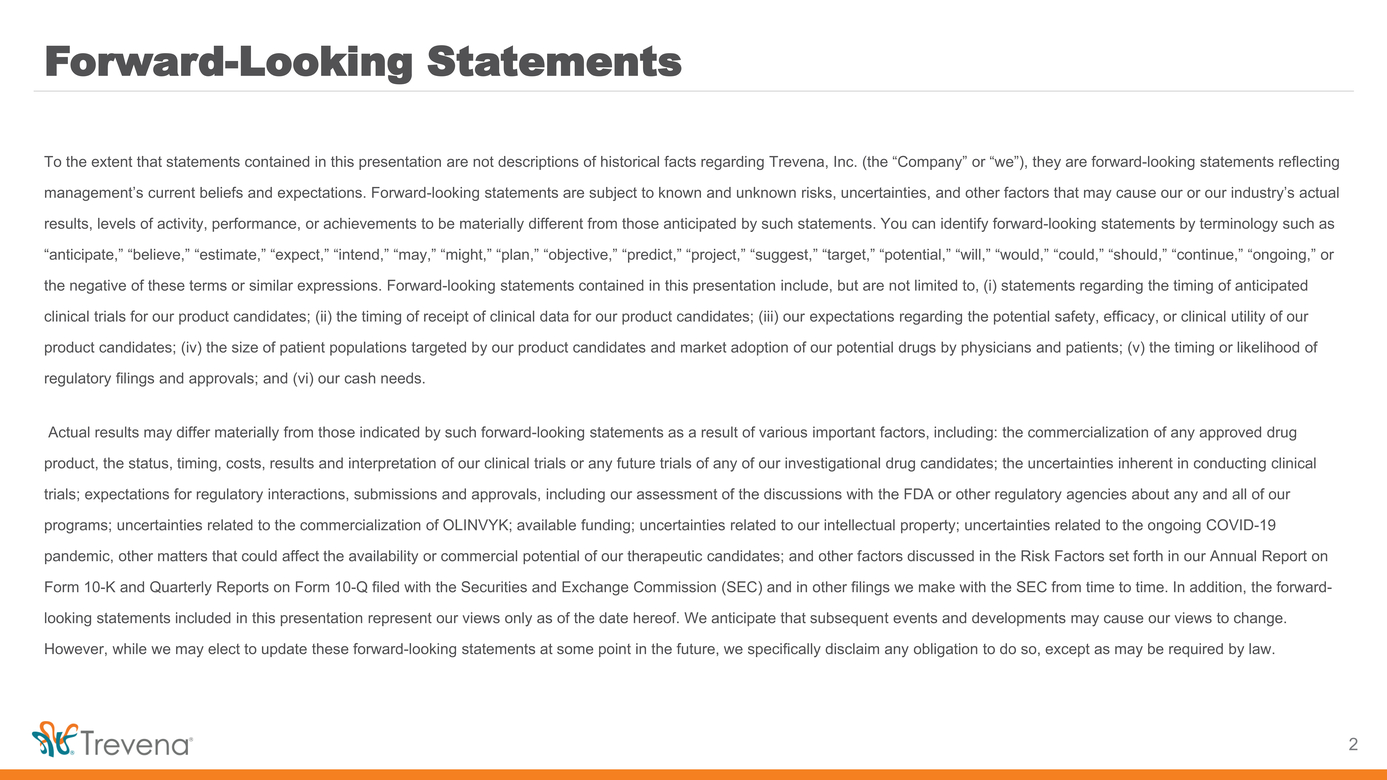 |
Forward-Looking Statements To the extent that statements contained in this presentation are not descriptions of historical facts regarding Trevena, Inc. (the “Company” or “we”), they are forward-looking statements reflecting management’s current beliefs and expectations. Forward-looking statements are subject to known and unknown risks, uncertainties, and other factors that may cause our or our industry’s actual results, levels of activity, performance, or achievements to be materially different from those anticipated by such statements. You can identify forward-looking statements by terminology such as “anticipate,” “believe,” “estimate,” “expect,” “intend,” “may,” “might,” “plan,” “objective,” “predict,” “project,” “suggest,” “target,” “potential,” “will,” “would,” “could,” “should,” “continue,” “ongoing,” or the negative of these terms or similar expressions. Forward-looking statements contained in this presentation include, but are not limited to, (i) statements regarding the timing of anticipated clinical trials for our product candidates; (ii) the timing of receipt of clinical data for our product candidates; (iii) our expectations regarding the potential safety, efficacy, or clinical utility of our product candidates; (iv) the size of patient populations targeted by our product candidates and market adoption of our potential drugs by physicians and patients; (v) the timing or likelihood of regulatory filings and approvals; and (vi) our cash needs. Actual results may differ materially from those indicated by such forward-looking statements as a result of various important factors, including: the commercialization of any approved drug product, the status, timing, costs, results and interpretation of our clinical trials or any future trials of any of our investigational drug candidates; the uncertainties inherent in conducting clinical trials; expectations for regulatory interactions, submissions and approvals, including our assessment of the discussions with the FDA or other regulatory agencies about any and all of our programs; uncertainties related to the commercialization of OLINVYK; available funding; uncertainties related to our intellectual property; uncertainties related to the ongoing COVID-19 pandemic, other matters that could affect the availability or commercial potential of our therapeutic candidates; and other factors discussed in the Risk Factors set forth in our Annual Report on Form 10-K and Quarterly Reports on Form 10-Q filed with the Securities and Exchange Commission (SEC) and in other filings we make with the SEC from time to time. In addition, the forward-looking statements included in this presentation represent our views only as of the date hereof. We anticipate that subsequent events and developments may cause our views to change. However, while we may elect to update these forward-looking statements at some point in the future, we specifically disclaim any obligation to do so, except as may be required by law. |
 |
Trevena’s Experienced Leadership Team |
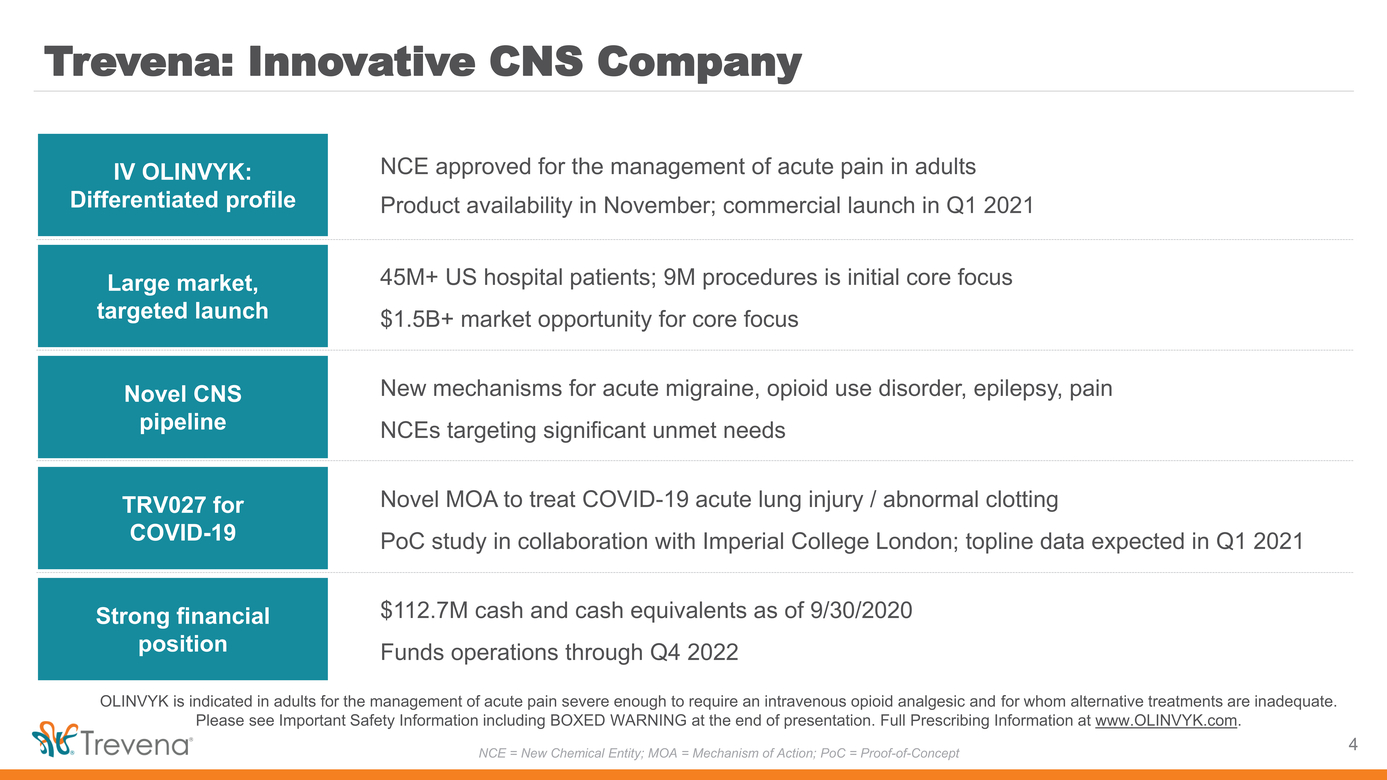 |
OLINVYK is indicated in adults for the management of acute pain severe enough to require an intravenous opioid analgesic and for whom alternative treatments are inadequate. Please see Important Safety Information including BOXED WARNING at the end of presentation. Full Prescribing Information at www.OLINVYK.com. |
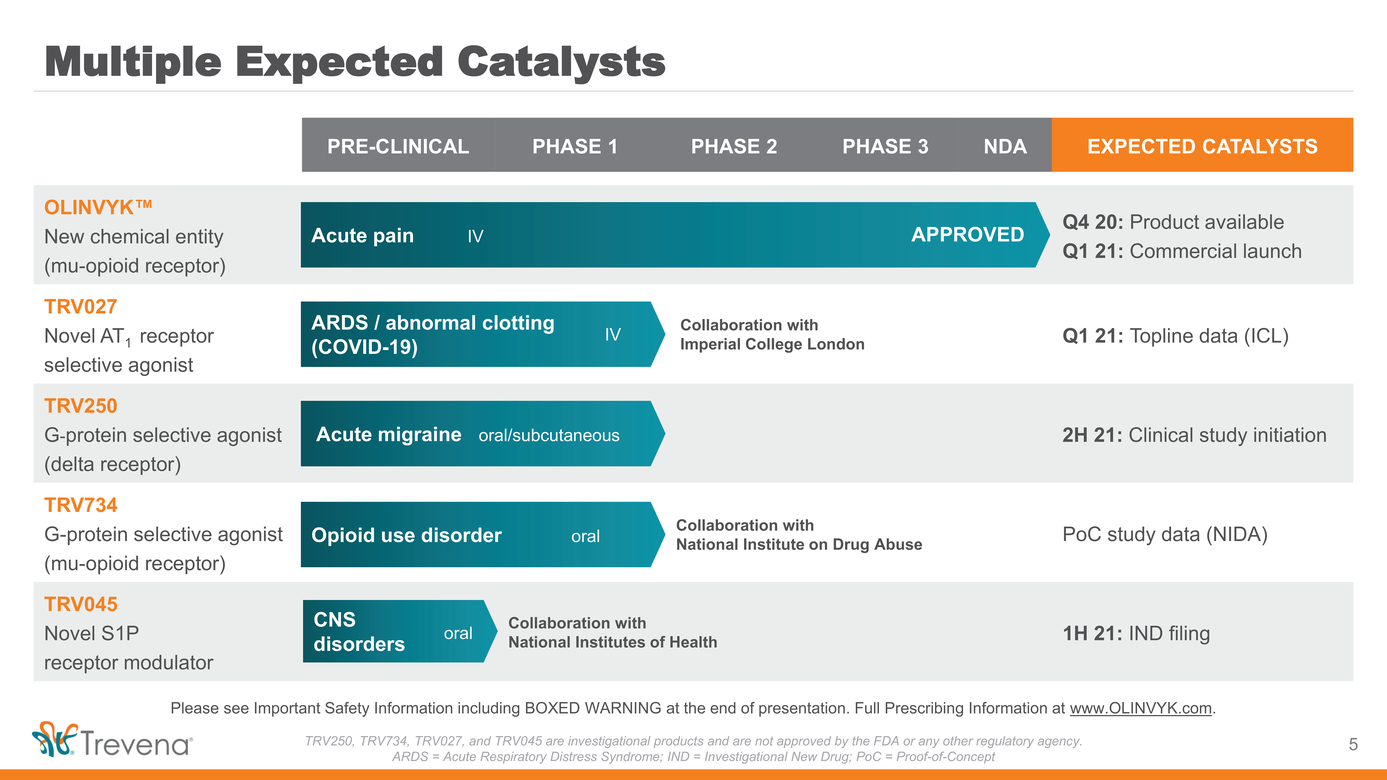 |
Please see Important Safety Information including BOXED WARNING at the end of presentation. Full Prescribing Information at www.OLINVYK.com. |
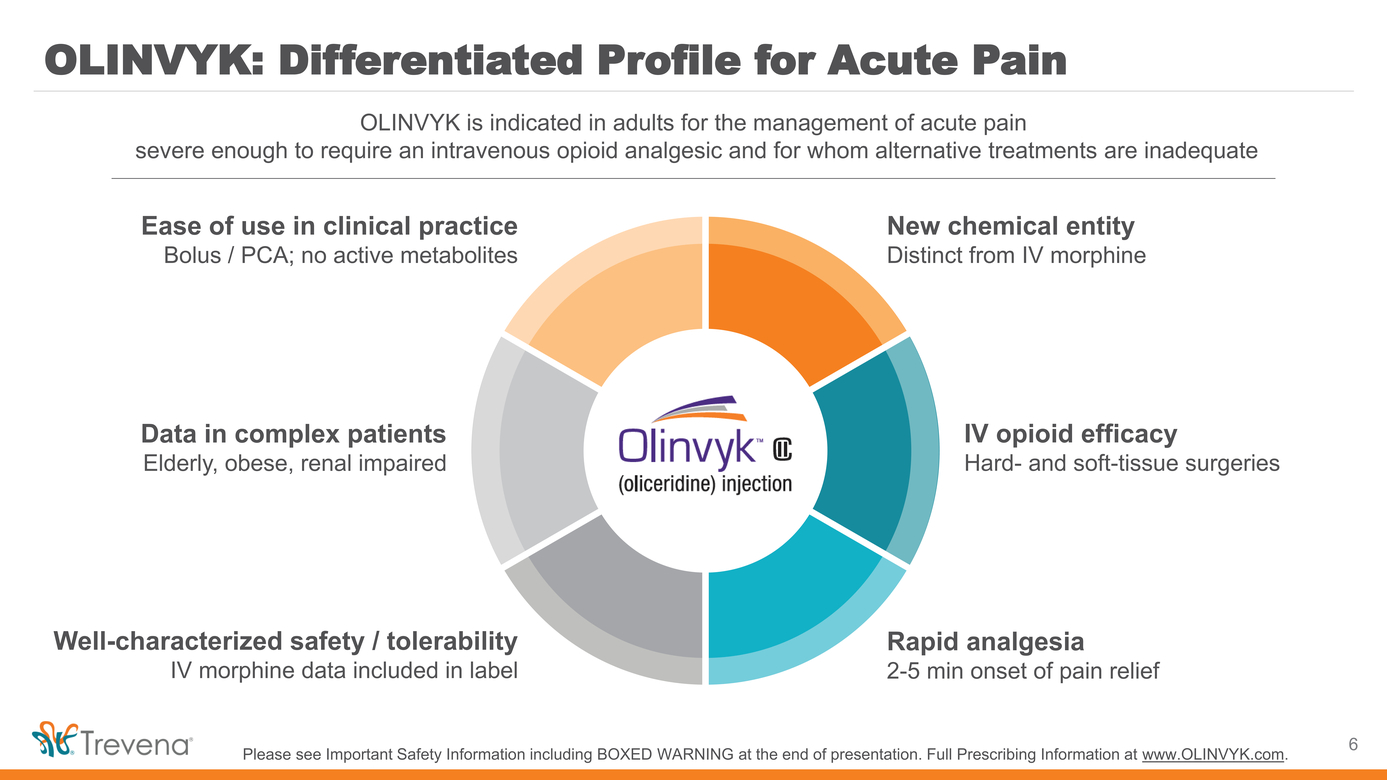 |
OLINVYK is indicated in adults for the management of acute pain severe enough to require an intravenous opioid analgesic and for whom alternative treatments are inadequate Ease of use in clinical practice Bolus / PCA; no active metabolites Data in complex patients Elderly, obese, renal impaired Well-characterized safety / tolerability IV morphine data included in label New chemical entity Distinct from IV morphine IV opioid efficacy Hard-and soft-tissue surgeries Rapid analgesia min onset of pain relief |
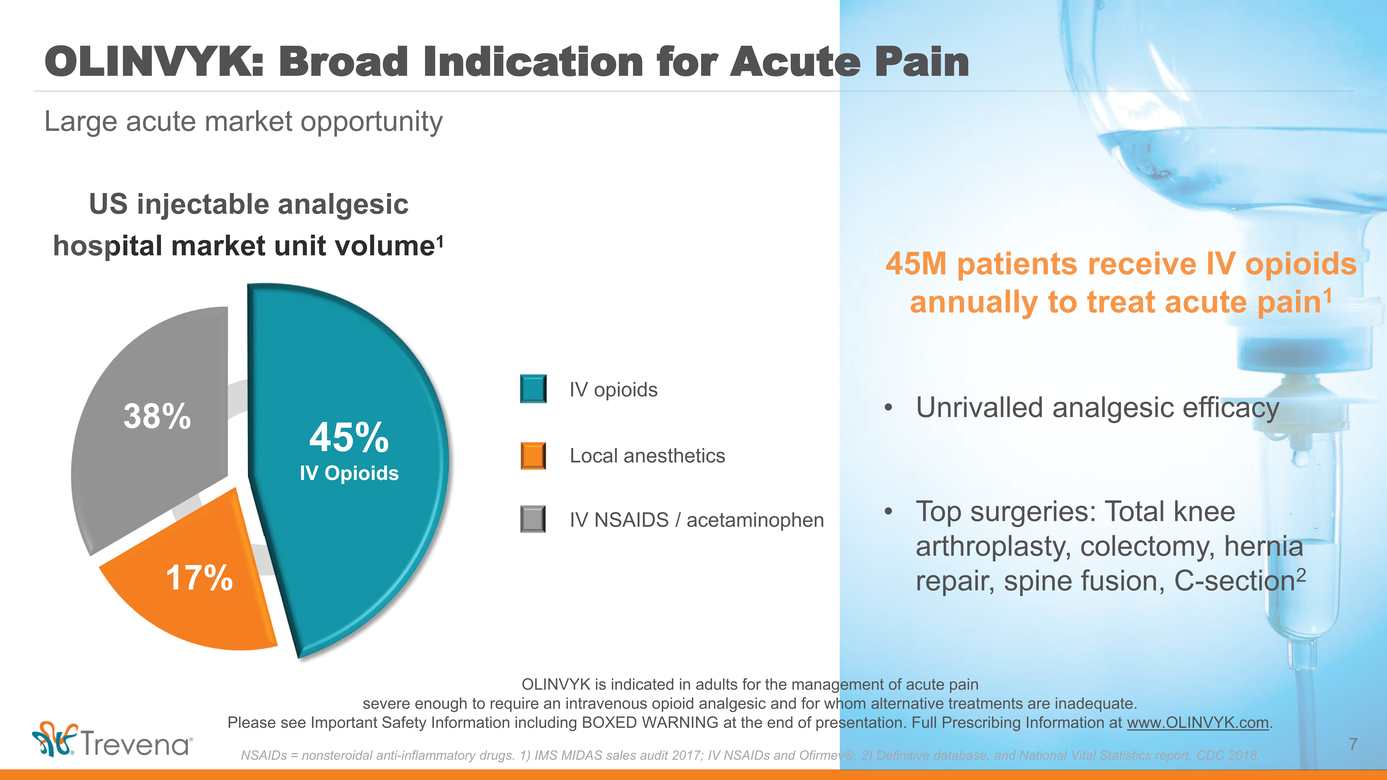 |
OLINVYK: Broad Indication for Acute Pain Large acute market opportunity US injectable analgesic hospital market unit volume1 45M patients receive IV opioids annually to treat acute pain1 38% 17% 45% IV Opioids IV opioids Local anesthetics IV NSAIDS / acetaminophen Unrivalled analgesic efficacy Top surgeries: Total knee arthroplasty, colectomy, hernia repair, spine fusion, C-section2 OLINVYK is indicated in adults for the management of acute pain severe enough to require an intravenous opioid analgesic and for whom alternative treatments are inadequate. Please see Important Safety Information including BOXED WARNING at the end of presentation. Full Prescribing Information at www.OLINVYK.com. 7 NSAIDs = nonsteroidal anti-inflammatory drugs. 1) IMS MIDAS sales audit 2017; IV NSAIDs and Ofirmev®. 2) Definitive database, and National Vital Statistics report, CDC 2018. |
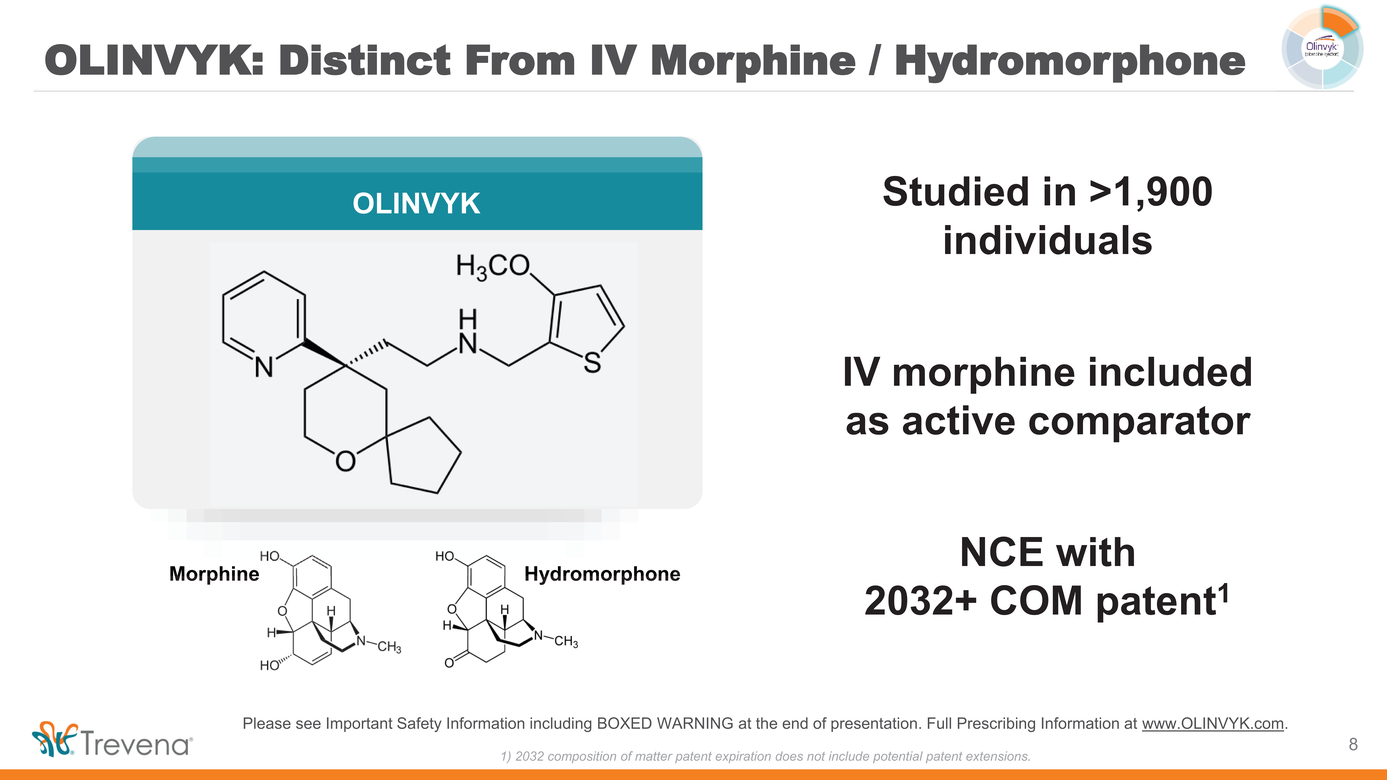 |
Morphine Hydromorphone OLINVYK IV morphine included as active comparator NCE with 2032+ COM patent1 Please see Important Safety Information including BOXED WARNING at the end of presentation. Full Prescribing Information at www.OLINVYK.com. 8 2032 composition of matter patent expiration does not include potential patent extensions. |
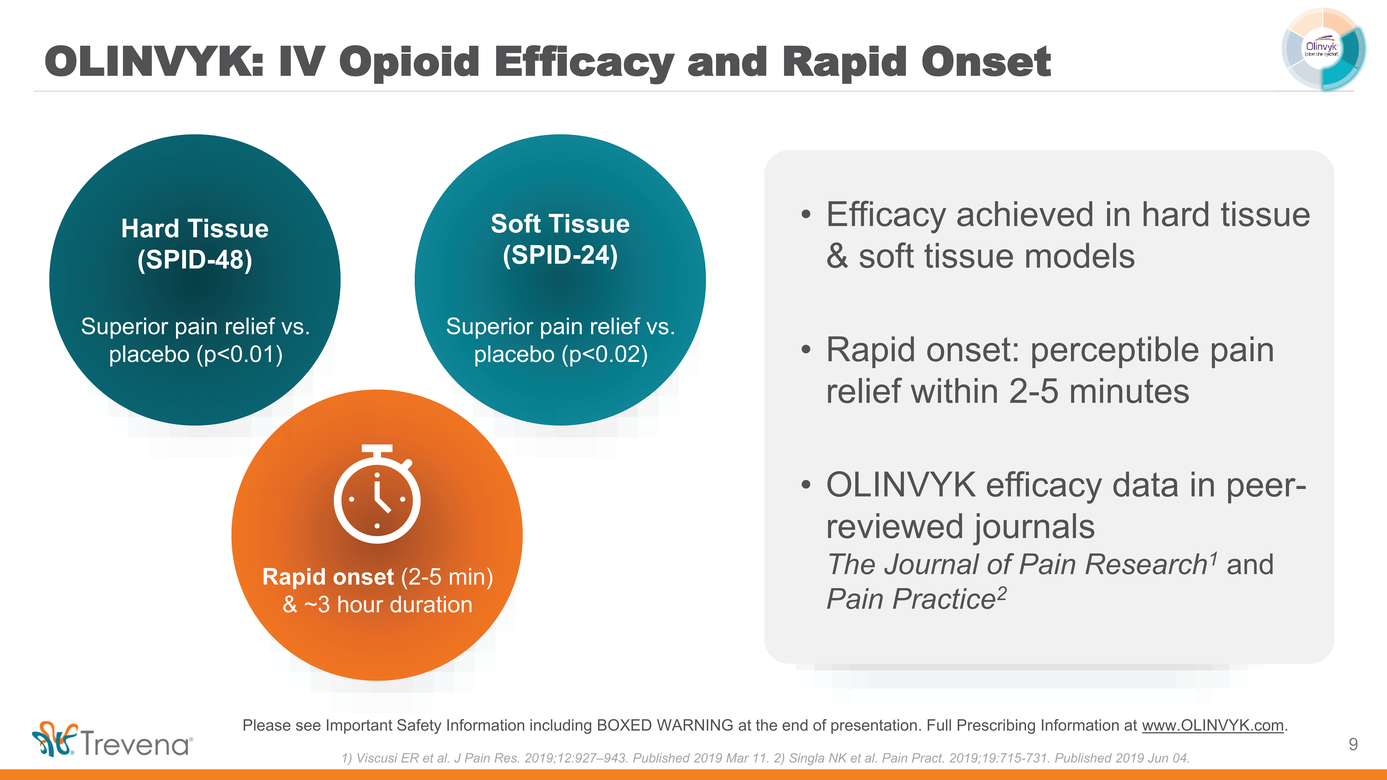 |
Hard Tissue (SPID-48) Superior pain relief vs. placebo (p<0.01) Soft Tissue (SPID-24) Superior pain relief vs. placebo (p<0.02) Efficacy achieved in hard tissue & soft tissue models Rapid onset: perceptible pain relief within 2-5 minutes Rapid onset (2-5 min) & ~3 hour duration OLINVYK efficacy data in peer-reviewed journals The Journal of Pain Research1 and Pain Practice2 Please see Important Safety Information including BOXED WARNING at the end of presentation. Full Prescribing Information at www.OLINVYK.com. 9 Viscusi ER et al. J Pain Res. 2019;12:927–943. Published 2019 Mar 11. 2) Singla NK et al. Pain Pract. 2019;19:715-731. Published 2019 Jun 04. |
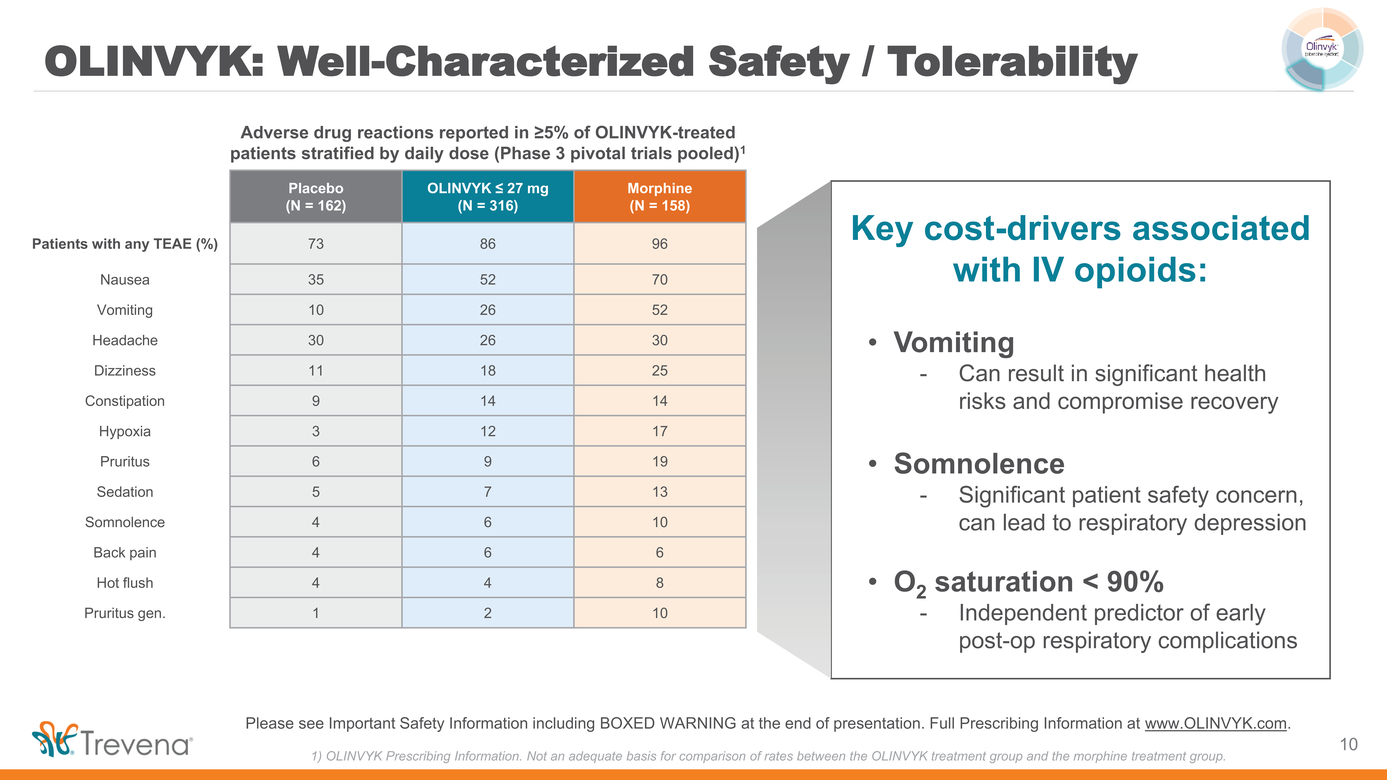 |
Placebo (N = 162) OLINVYK ≤ 27 mg (N = 316) Morphine (N = 158) Patients with any TEAE (%) 73 86 96 Nausea 35 52 70 Vomiting 10 26 52 Headache 30 26 30 Dizziness 11 18 25 Constipation 9 14 14 Hypoxia 3 12 17 Pruritus 6 9 19 Sedation 5 7 13 Somnolence 4 6 10 Back pain 4 6 6 Hot flush 4 4 8 Pruritus gen. 1 2 10 O2 saturation < 90% -Independent predictor of early post-op respiratory complications Significant patient safety concern, can lead to respiratory depression - Somnolence Can result in significant health risks and compromise recovery - Vomiting Key cost-drivers associated with IV opioids: |
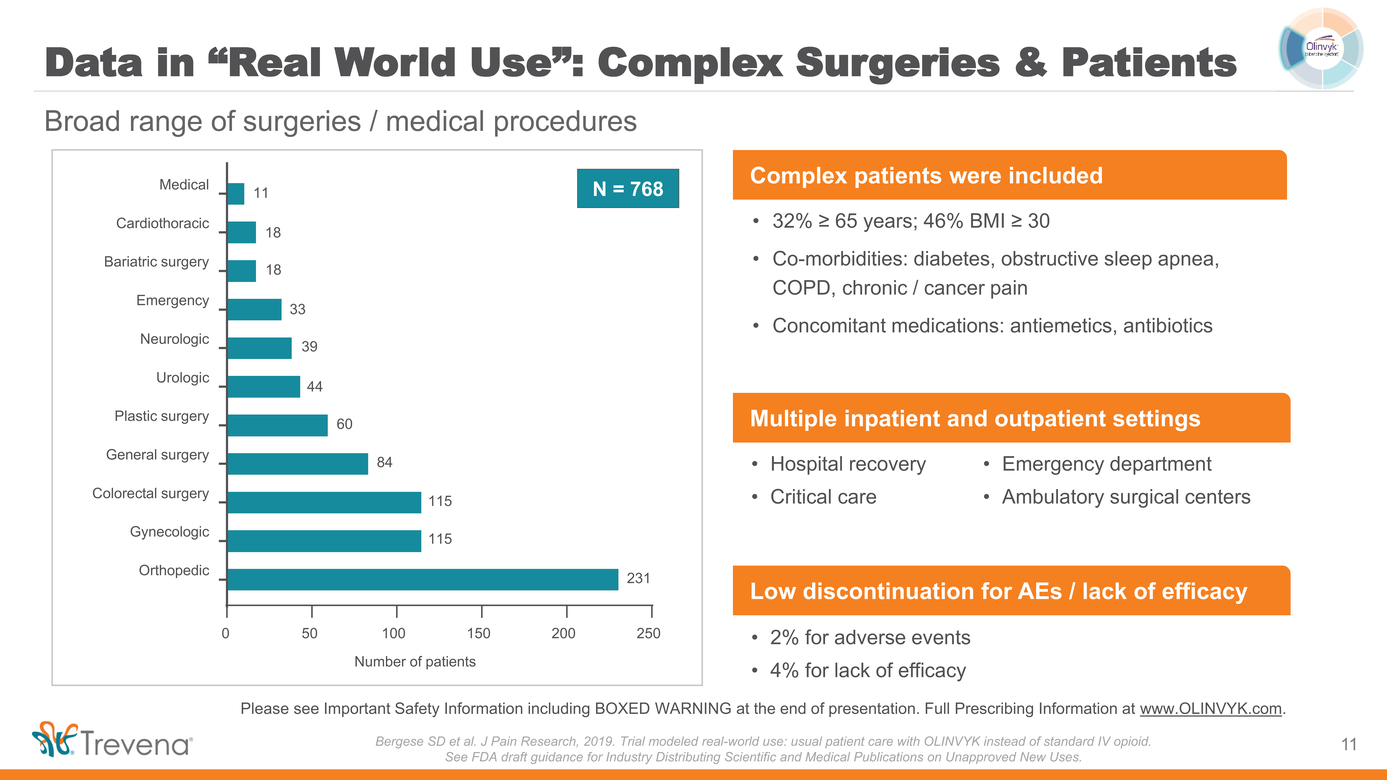 |
s Broad range of surgeries / medical procedures Complex patients were included 32% ≥ 65 years; 46% BMI ≥ 30 Number of patients 250 200 150 100 50 0 231 Orthopedic 115 Gynecologic 115 Colorectal surgery 84 General surgery 60 Plastic surgery 44 Urologic 39 Neurologic 33 Emergency 18 Bariatric surgery 18 Cardiothoracic 11 Medical N = 768 Concomitant medications: antiemetics, antibiotics Multiple inpatient and outpatient settings Low discontinuation for AEs / lack of efficacy 2% for adverse events 4% for lack of efficacy |
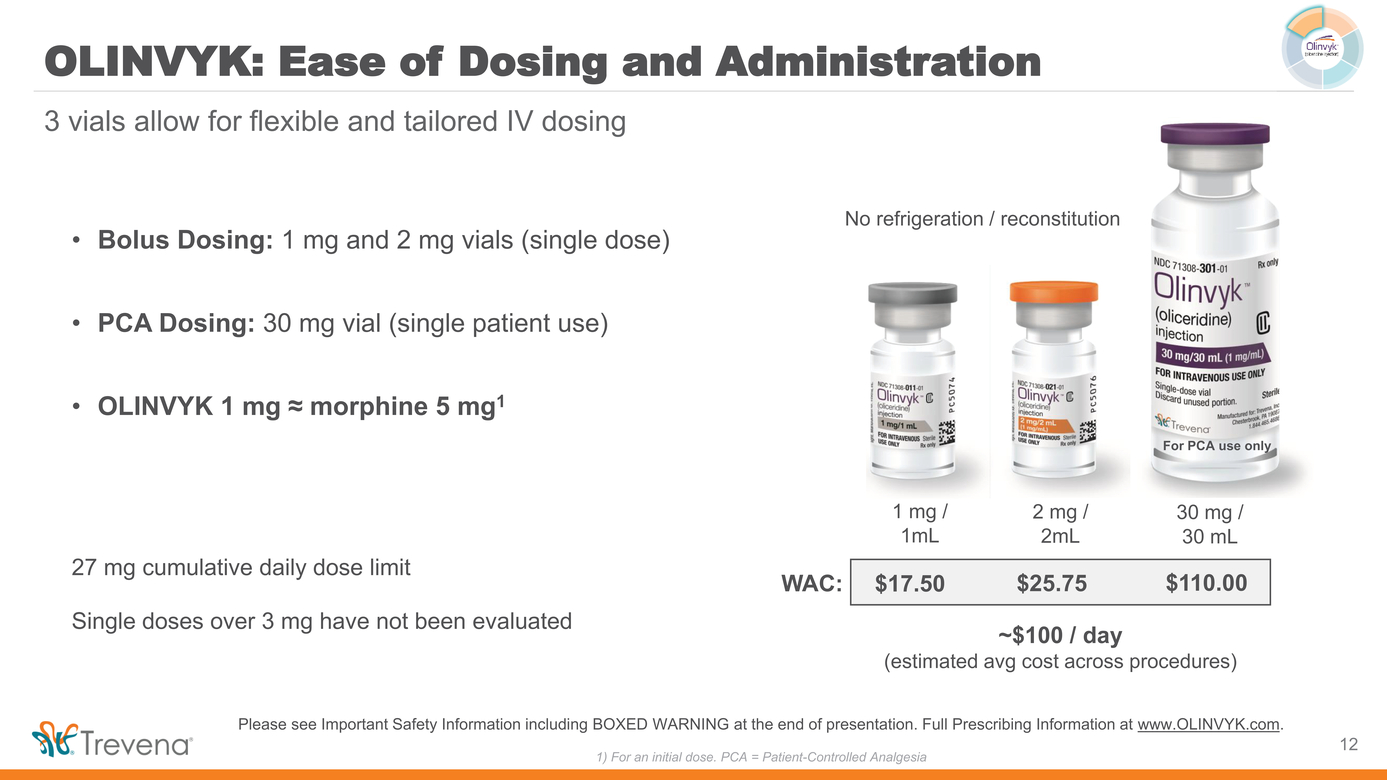 |
n For PCA use only Bolus Dosing: 1 mg and 2 mg vials (single dose) PCA Dosing: 30 mg vial (single patient use) OLINVYK 1 mg ≈ morphine 5 mg1 No refrigeration / reconstitution 27 mg cumulative daily dose limit Single doses over 3 mg have not been evaluated WAC: 1 mg / 1mL 2 mg / 2mL $17.50$25.75$110.00 30 mg / 30 mL (estimated avg cost across procedures) |
 |
Customer Engagement Strategy |
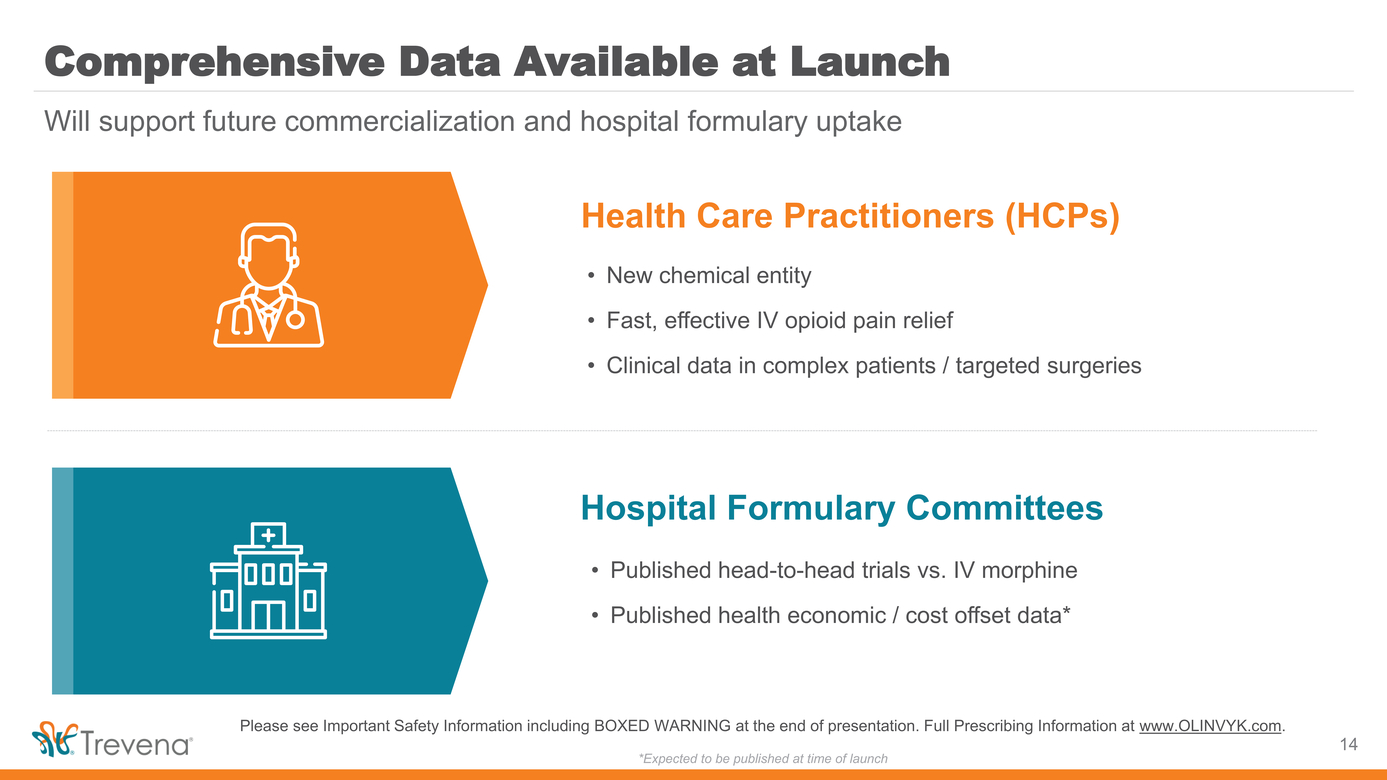 |
Will support future commercialization and hospital formulary uptake Health Care Practitioners (HCPs) New chemical entity Fast, effective IV opioid pain relief Clinical data in complex patients / targeted surgeries Hospital Formulary Committees Published head-to-head trials vs. IV morphine Published health economic / cost offset data* |
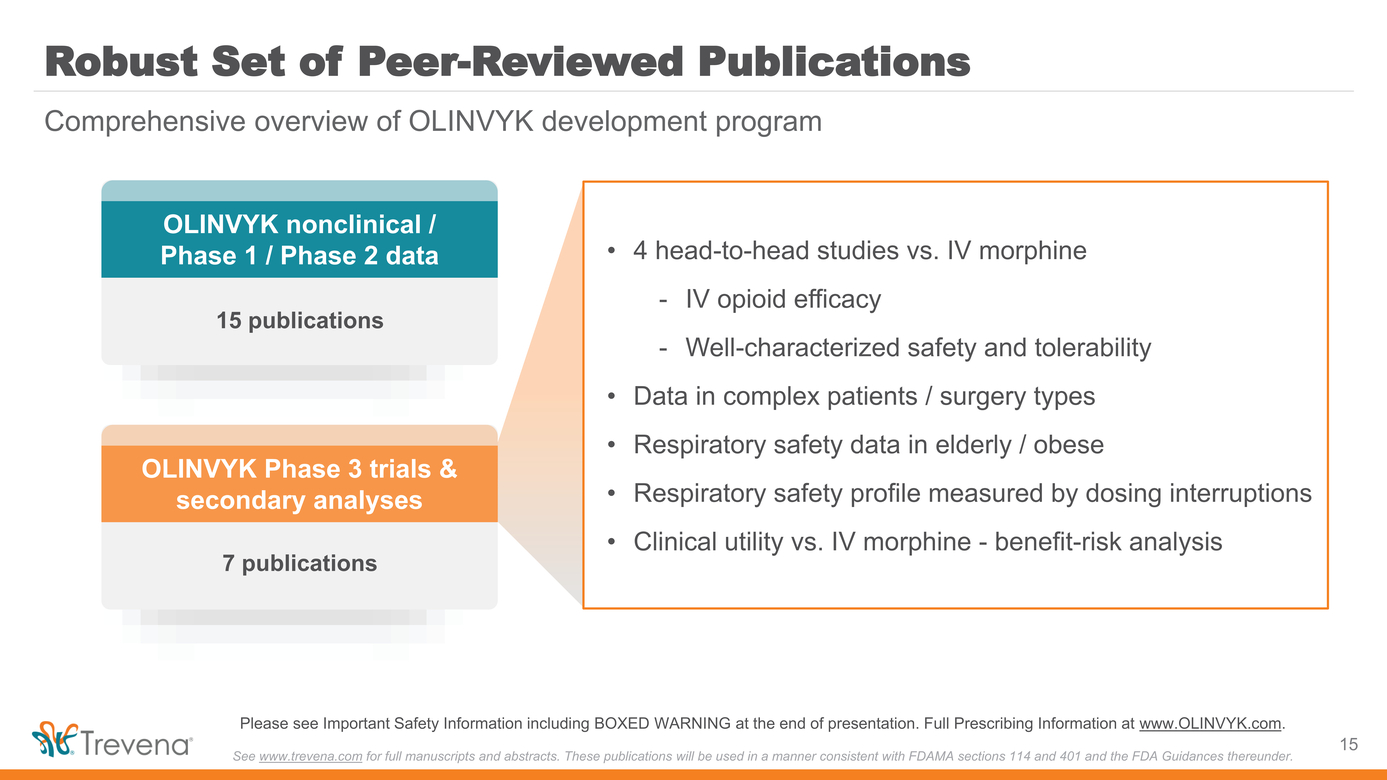 |
Comprehensive overview of OLINVYK development program 15 publications 7 publications OLINVYK Phase 3 trials & secondary analyses OLINVYK nonclinical / Phase 1 / Phase 2 data 4 head-to-head studies vs. IV morphine IV opioid efficacy Well-characterized safety and tolerability Data in complex patients / surgery types Respiratory safety data in elderly / obese Respiratory safety profile measured by dosing interruptions Clinical utility vs. IV morphine - benefit-risk analysis |
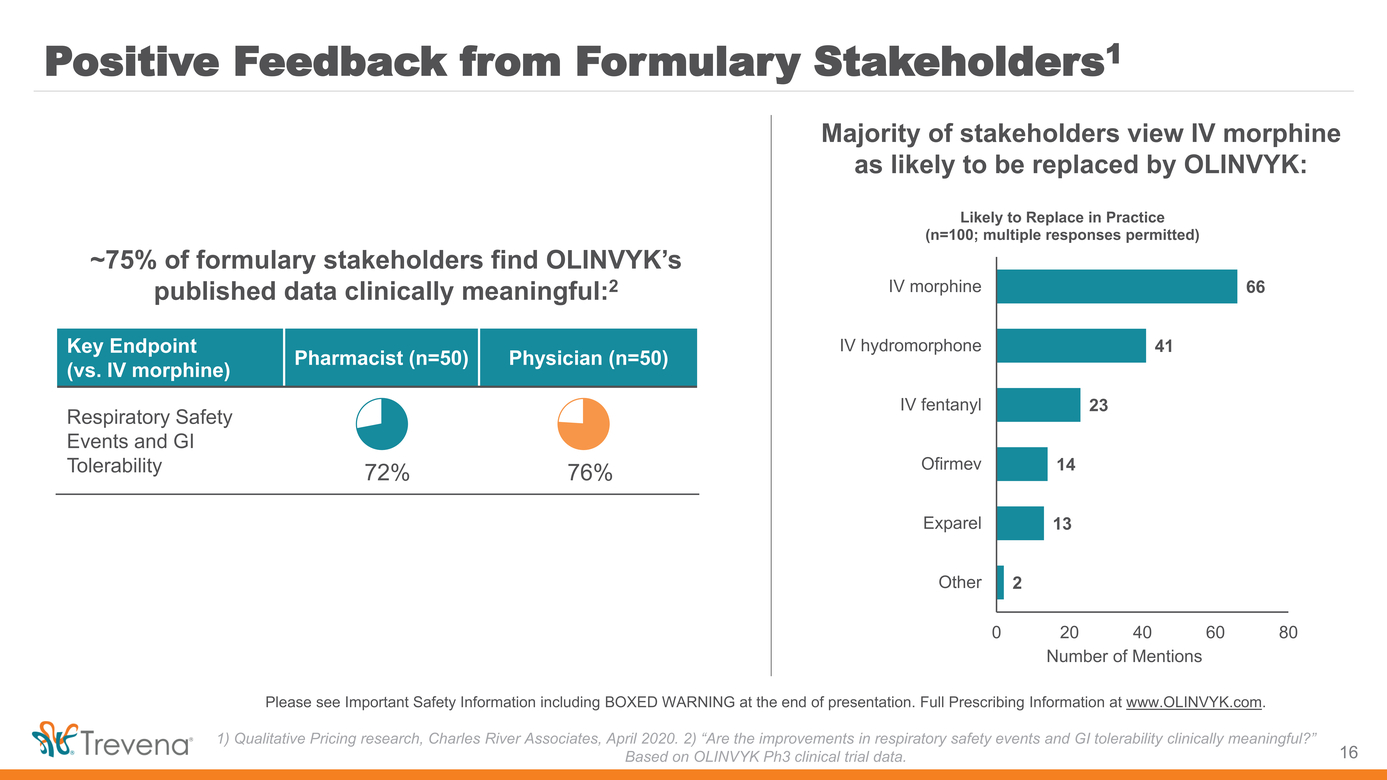 |
Majority of stakeholders view IV morphine as likely to be replaced by OLINVYK: ~75% of formulary stakeholders find OLINVYK’s published data clinically meaningful:2 Likely to Replace in Practice (n=100; multiple responses permitted) 66 41 23 14 13 2 IV fentanyl Ofirmev Exparel Other 020406080 Number of Mentions Please see Important Safety Information including BOXED WARNING at the end of presentation. Full Prescribing Information at www.OLINVYK.com. |
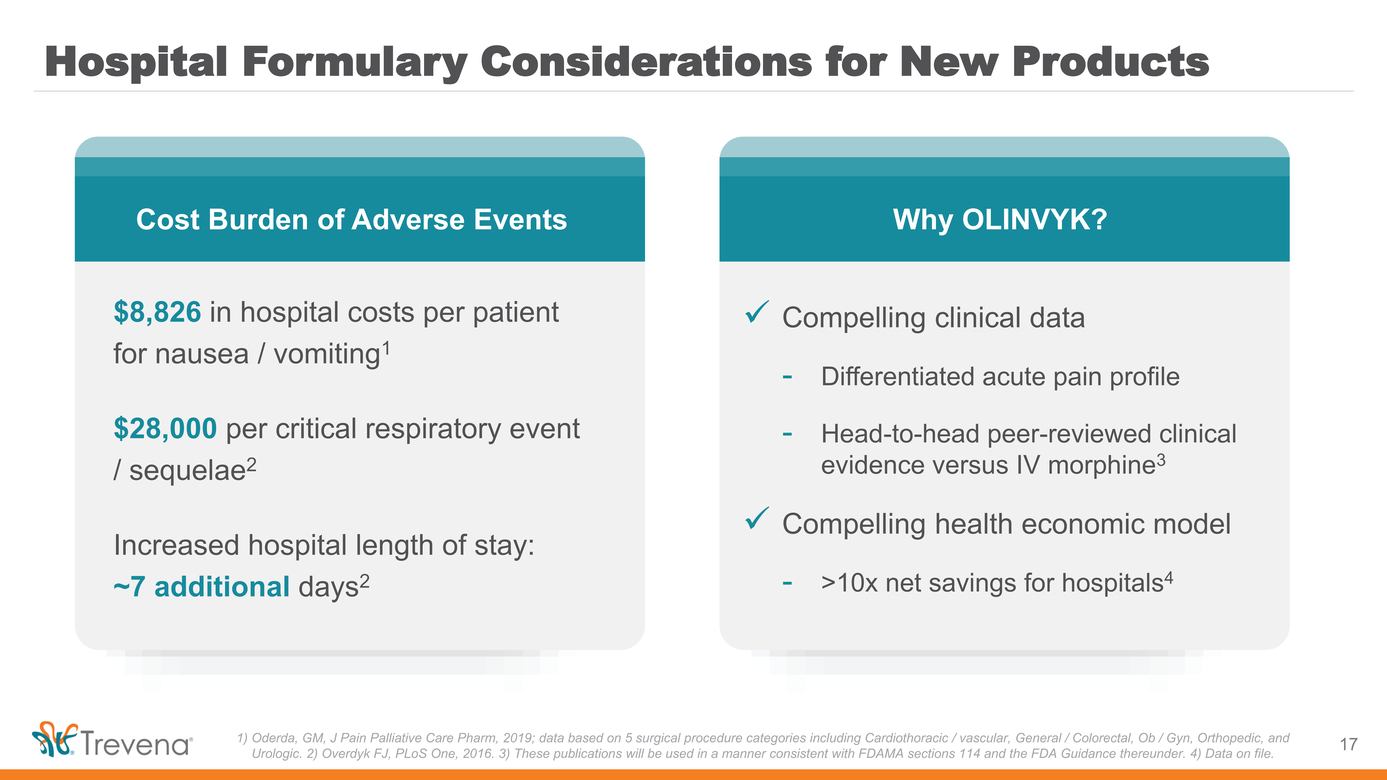 |
$8,826 in hospital costs per patient for nausea / vomiting1 $28,000 per critical respiratory event / sequelae2 Increased hospital length of stay: ~7 additional days2 Cost Burden of Adverse Events Compelling clinical data - - Differentiated acute pain profile Head-to-head peer-reviewed clinical evidence versus IV morphine3 Compelling health economic model ->10x net savings for hospitals4 Why OLINVYK? |
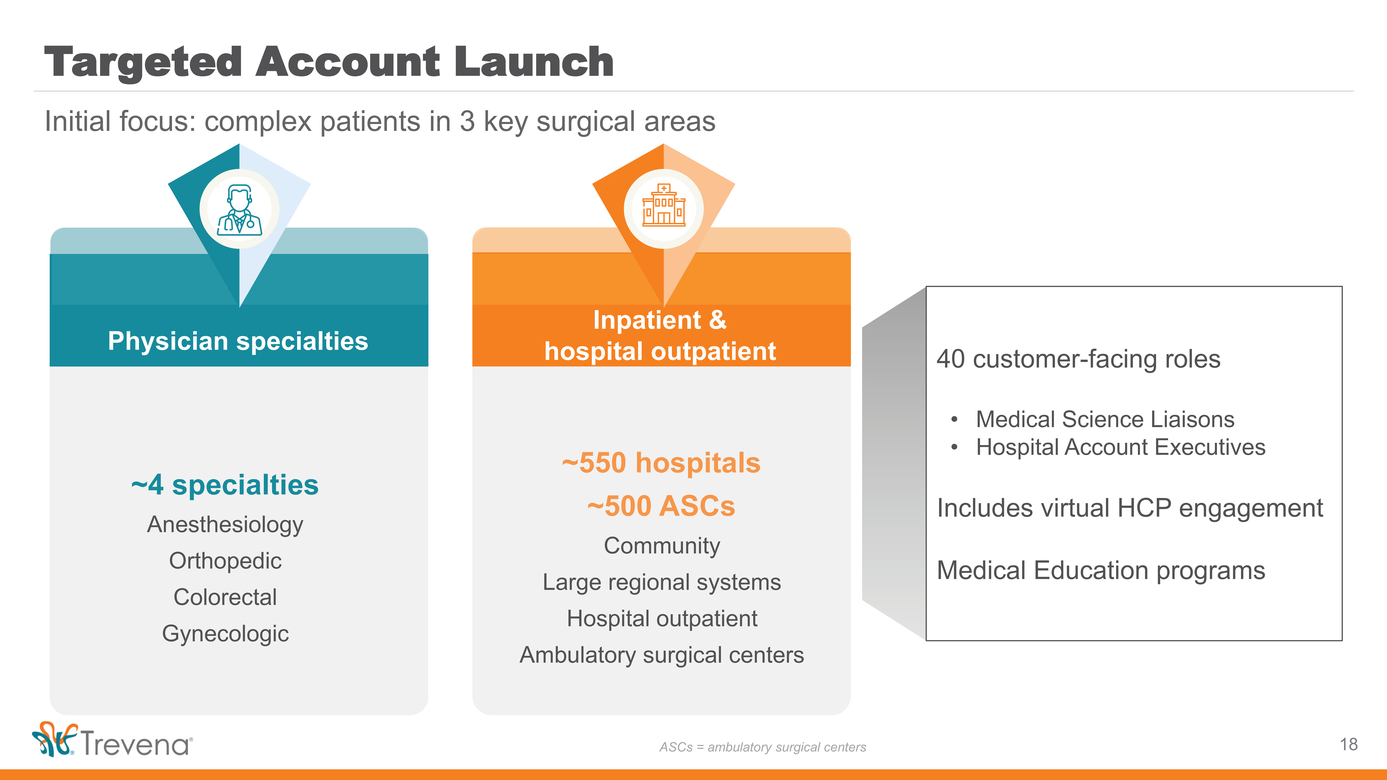 |
40 customer-facing roles Medical Science Liaisons Hospital Account Executives Includes virtual HCP engagement Medical Education programs Physician specialties ~4 specialties Anesthesiology Orthopedic Colorectal Gynecologic ~550 hospitals ~500 ASCs Community Large regional systems Hospital outpatient Ambulatory surgical centers Inpatient & hospital outpatient |
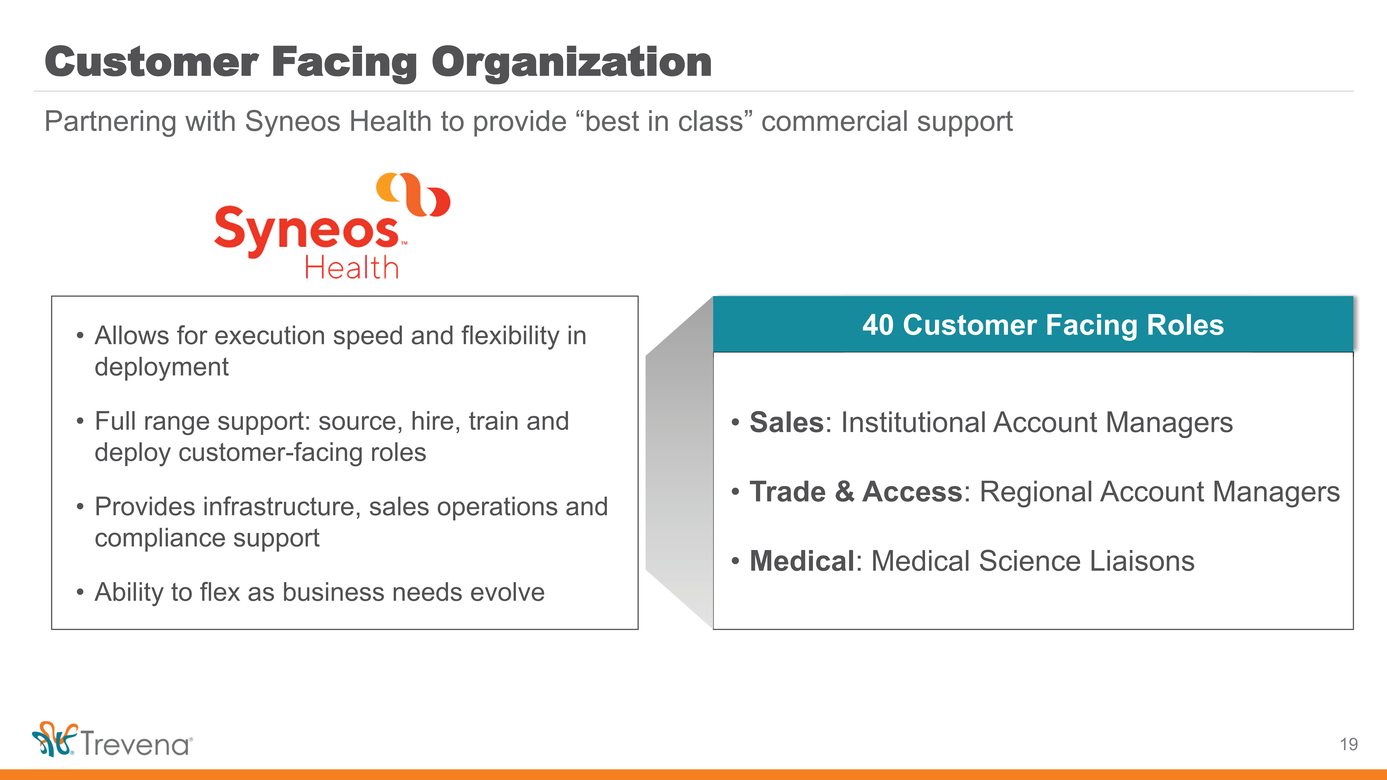 |
Partnering with Syneos Health to provide “best in class” commercial support Allows for execution speed and flexibility in deployment Full range support: source, hire, train and deploy customer-facing roles Provides infrastructure, sales operations and compliance support Ability to flex as business needs evolve Medical: Medical Science Liaisons Trade & Access: Regional Account Managers Sales: Institutional Account Managers 40 Customer Facing Roles |
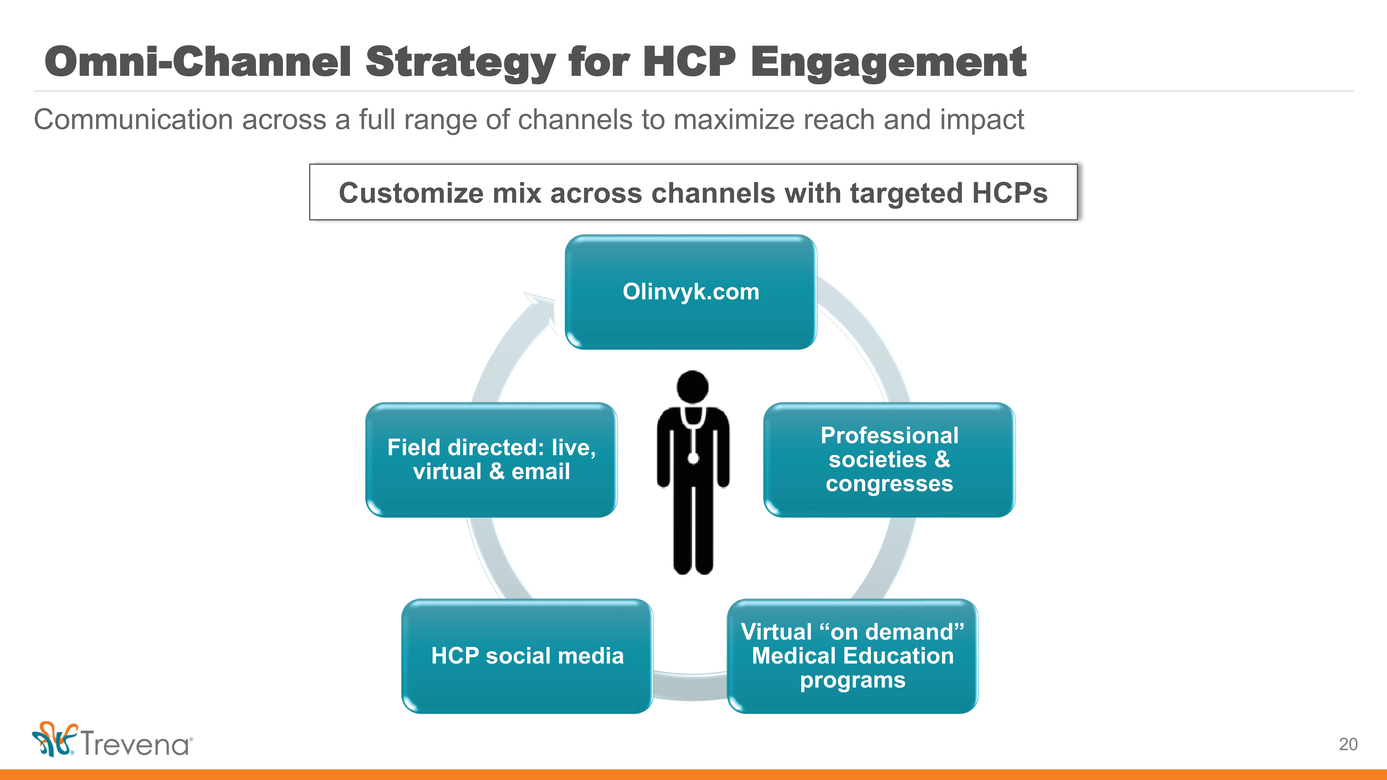 |
Communication across a full range of channels to maximize reach and impact Olinvyk.com Field directed: live, virtual & email Professional societies & congresses HCP social media Virtual “on demand” Medical Education programs Customize mix across channels with targeted HCPs |
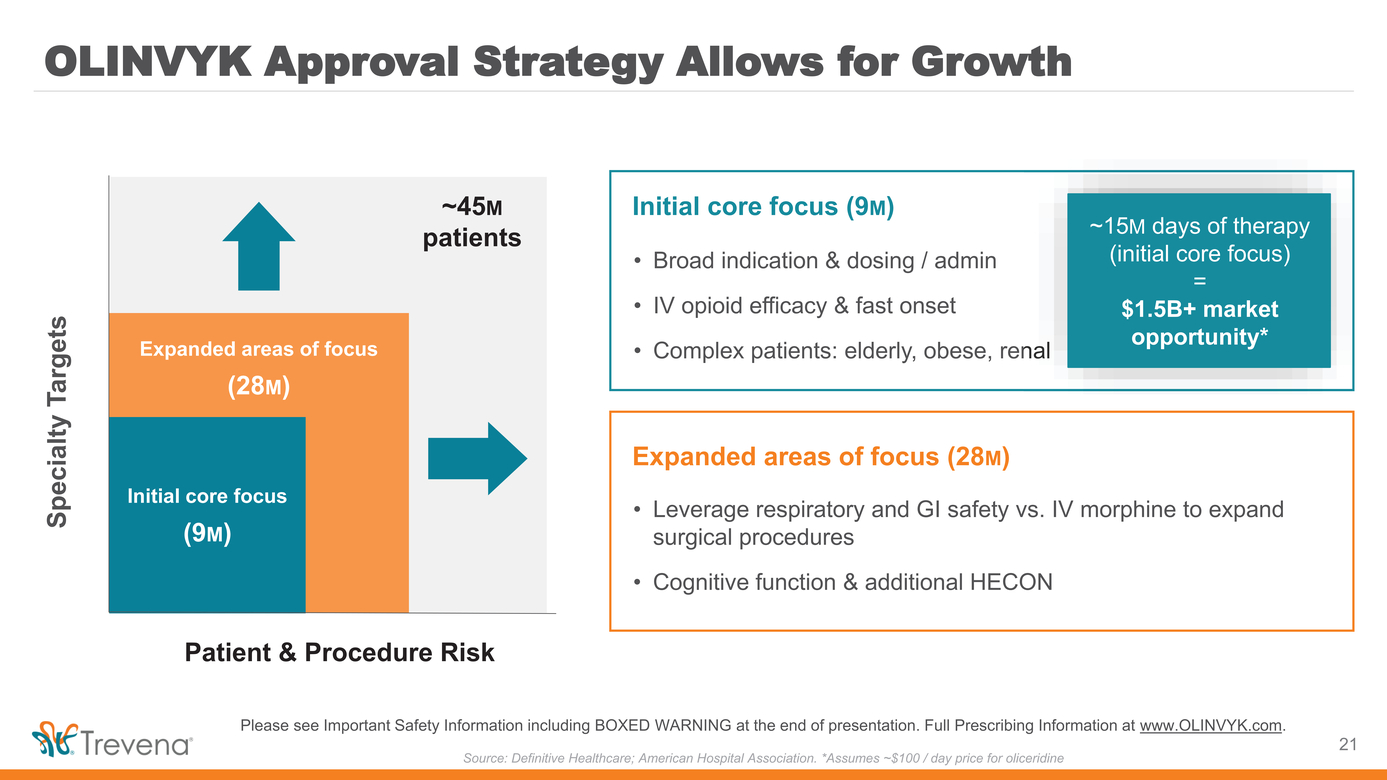 |
Initial core focus (9M) Broad indication & dosing / admin IV opioid efficacy & fast onset Complex patients: elderly, obese, renal ~15M days of therapy (initial core focus) = $1.5B+ market opportunity* Initial launch focus Initial core focus (9M) Expanded areas of focus (28M) ~45M patients Expanded areas of focus (28M) Leverage respiratory and GI safety vs. IV morphine to expand surgical procedures Cognitive function & additional HECON Specialty Targets Please see Important Safety Information including BOXED WARNING at the end of presentation. Full Prescribing Information at www.OLINVYK.com. 21 |
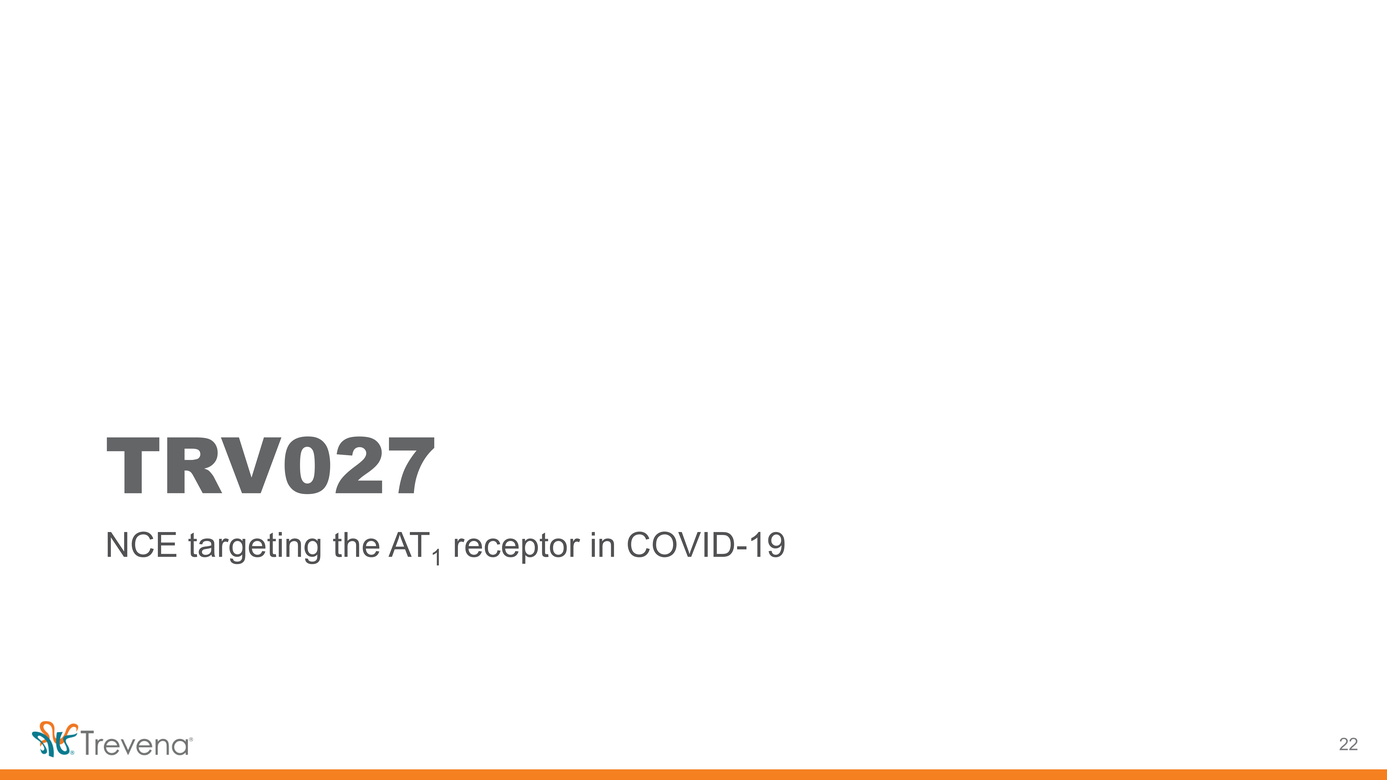 |
TRV027 NCE targeting the AT1 receptor in COVID-19 |
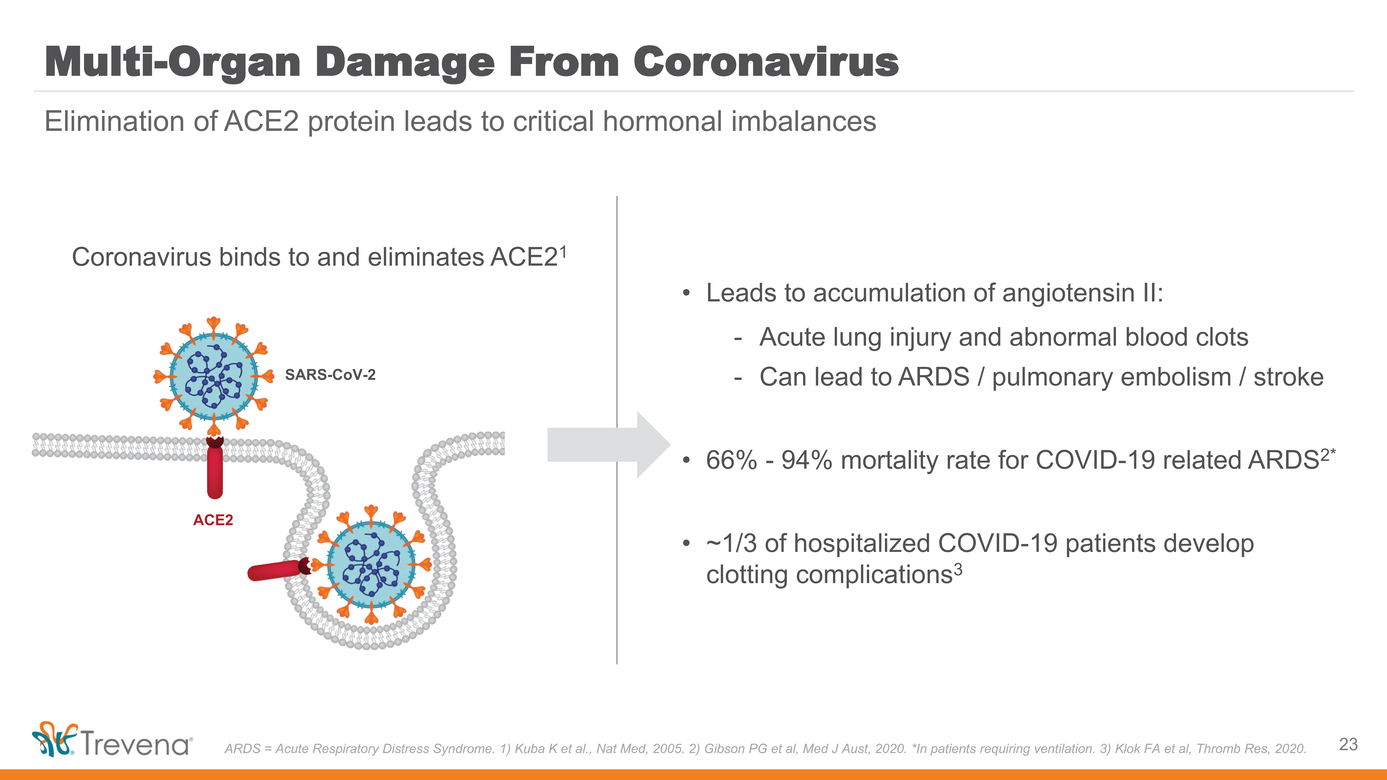 |
Elimination of ACE2 protein leads to critical hormonal imbalances SARS-CoV-2 ACE2 Leads to accumulation of angiotensin II: Acute lung injury and abnormal blood clots Can lead to ARDS / pulmonary embolism / stroke 66% - 94% mortality rate for COVID-19 related ARDS2* ~1/3 of hospitalized COVID-19 patients develop clotting complications3 |
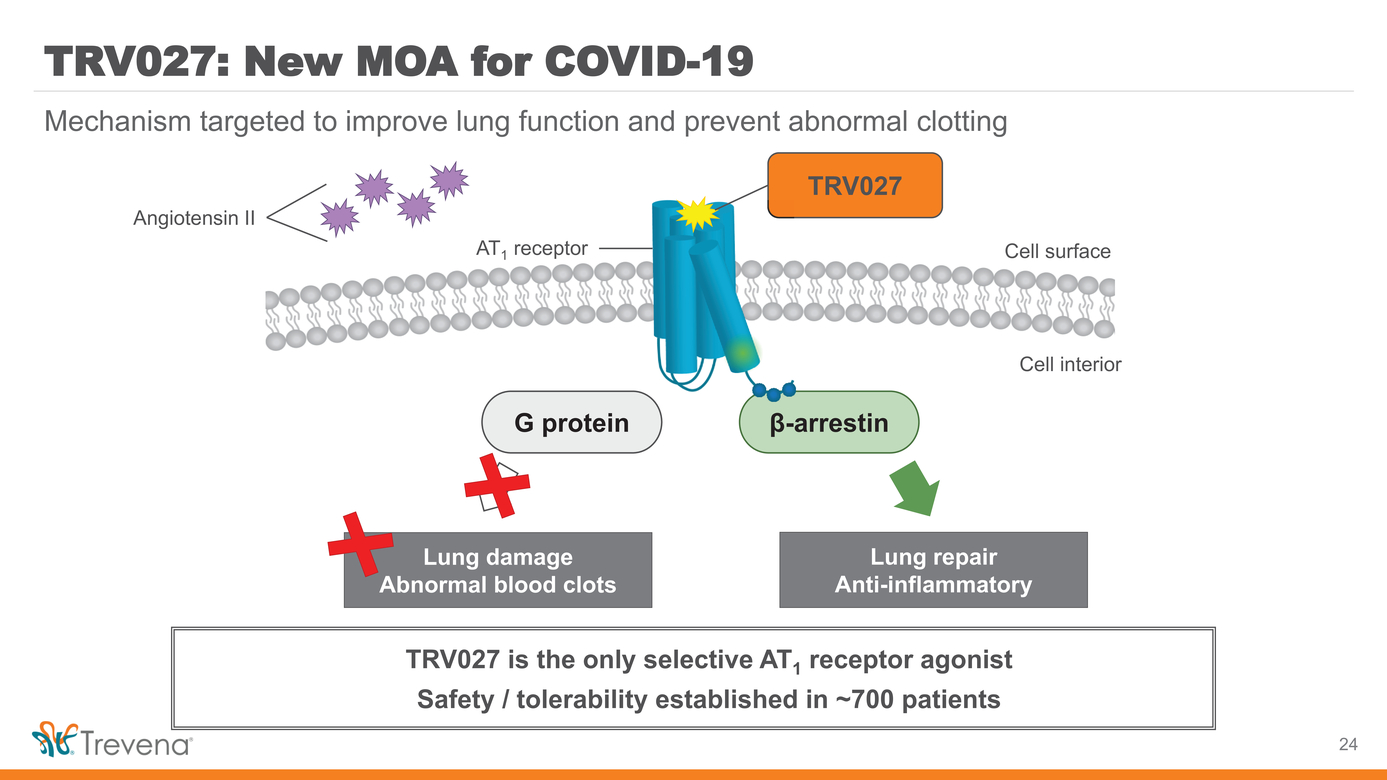 |
TRV027 is the only selective AT1 receptor agonist Safety / tolerability established in ~700 patients Mechanism targeted to improve lung function and prevent abnormal clotting TRV027 AT1 receptor Cell surface Cell interior G protein β-arrestin Lung damage Abnormal blood clots Lung repair Anti-inflammatory |
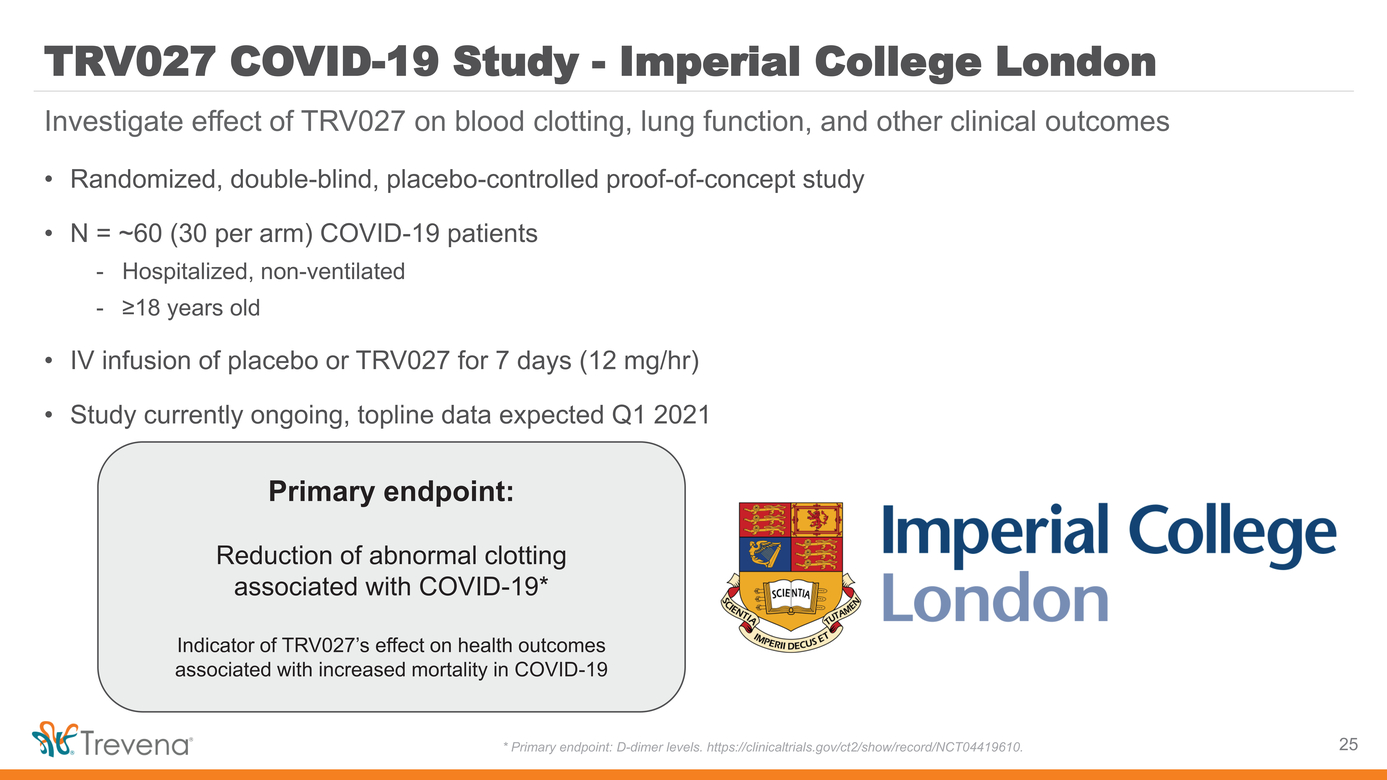 |
Investigate effect of TRV027 on blood clotting, lung function, and other clinical outcomes Randomized, double-blind, placebo-controlled proof-of-concept study N = ~60 (30 per arm) COVID-19 patients Hospitalized, non-ventilated ≥18 years old IV infusion of placebo or TRV027 for 7 days (12 mg/hr) Study currently ongoing, topline data expected Q1 2021 Primary endpoint: Reduction of abnormal clotting associated with COVID-19* Indicator of TRV027’s effect on health outcomes associated with increased mortality in COVID-19 |
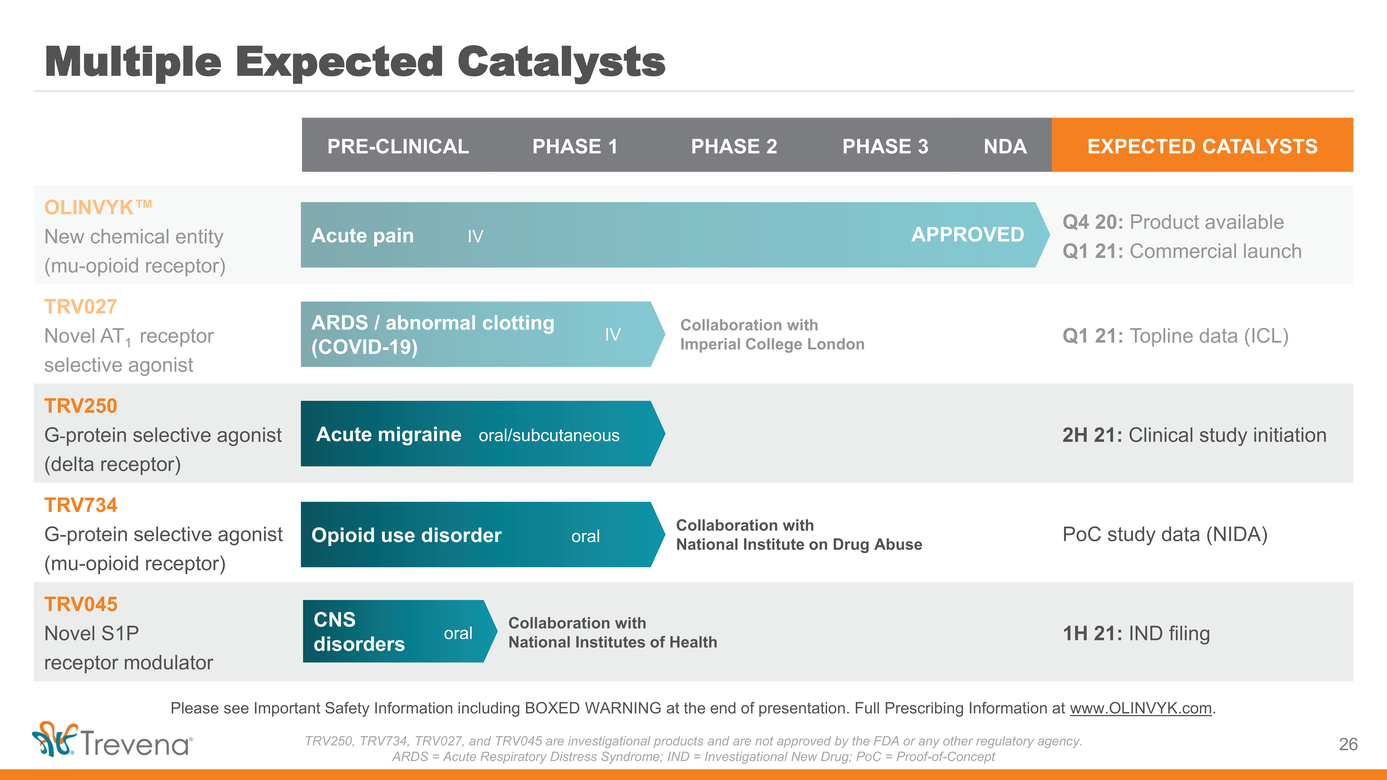 |
OLINVYK™Q4 20: Product available New chemical entityAcute painIVAPPROVEDQ1 21: Commercial launch (mu-opioid receptor) TRV027 ARDS / abnormal clottingCollaboration with Novel AT1 receptor(COVID-19)IVImperial College LondonQ1 21: Topline data (ICL) selective agonist Please see Important Safety Information including BOXED WARNING at the end of presentation. Full Prescribing Information at www.OLINVYK.com. TRV250, TRV734, TRV027, and TRV045 are investigational products and are not approved by the FDA or any other regulatory agency.26 |
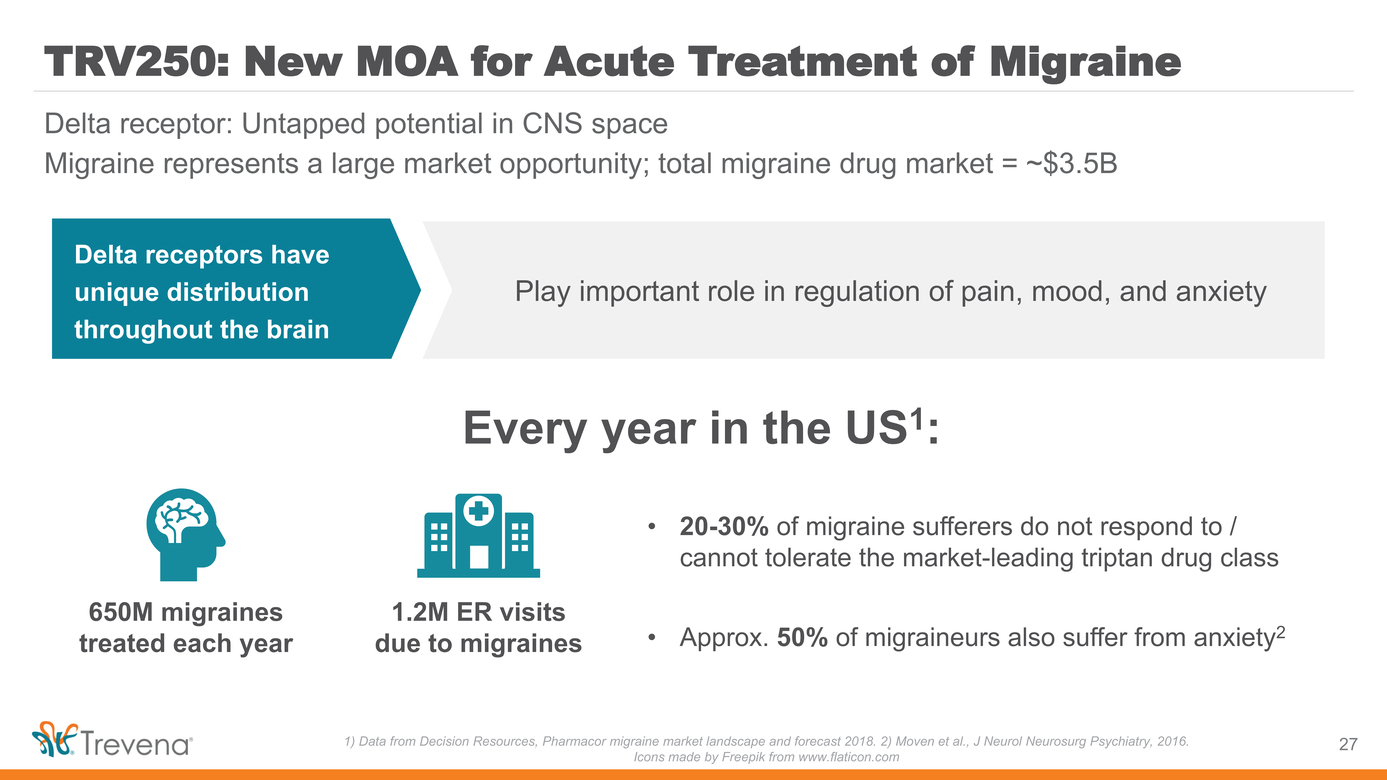 |
Delta receptor: Untapped potential in CNS space Migraine represents a large market opportunity; total migraine drug market = ~$3.5B Delta receptors have unique distribution throughout the brain Play important role in regulation of pain, mood, and anxiety Every year in the US1: 650M migraines treated each year M ER visits due to migraines 20-30% of migraine sufferers do not respond to / cannot tolerate the market-leading triptan drug class Approx. 50% of migraineurs also suffer from anxiety2 Data from Decision Resources, Pharmacor migraine market landscape and forecast 2018. 2) Moven et al., J Neurol Neurosurg Psychiatry, 2016.27 Icons made by Freepik from www.flaticon.com |
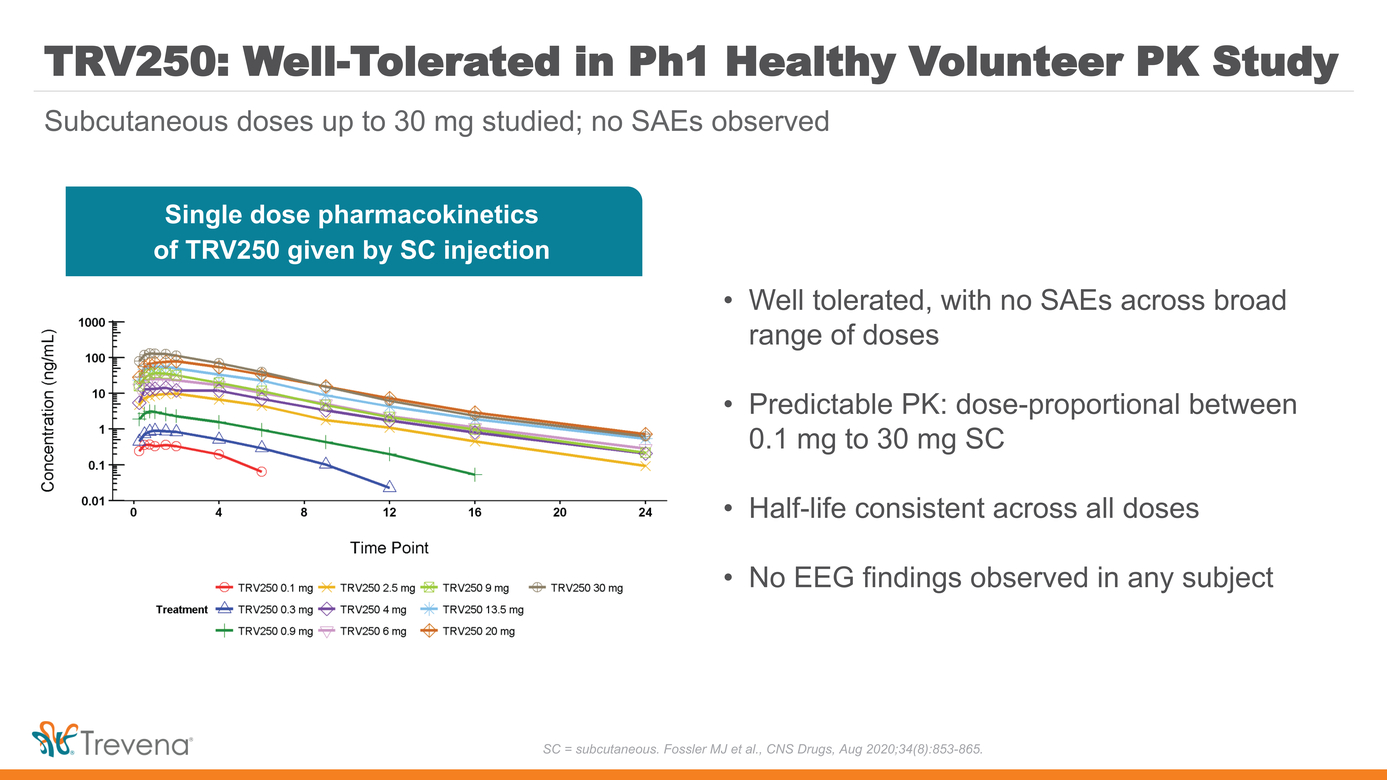 |
Subcutaneous doses up to 30 mg studied; no SAEs observed Single dose pharmacokinetics of TRV250 given by SC injection Well tolerated, with no SAEs across broad range of doses Predictable PK: dose-proportional between 0.1 mg to 30 mg SC Half-life consistent across all doses No EEG findings observed in any subject |
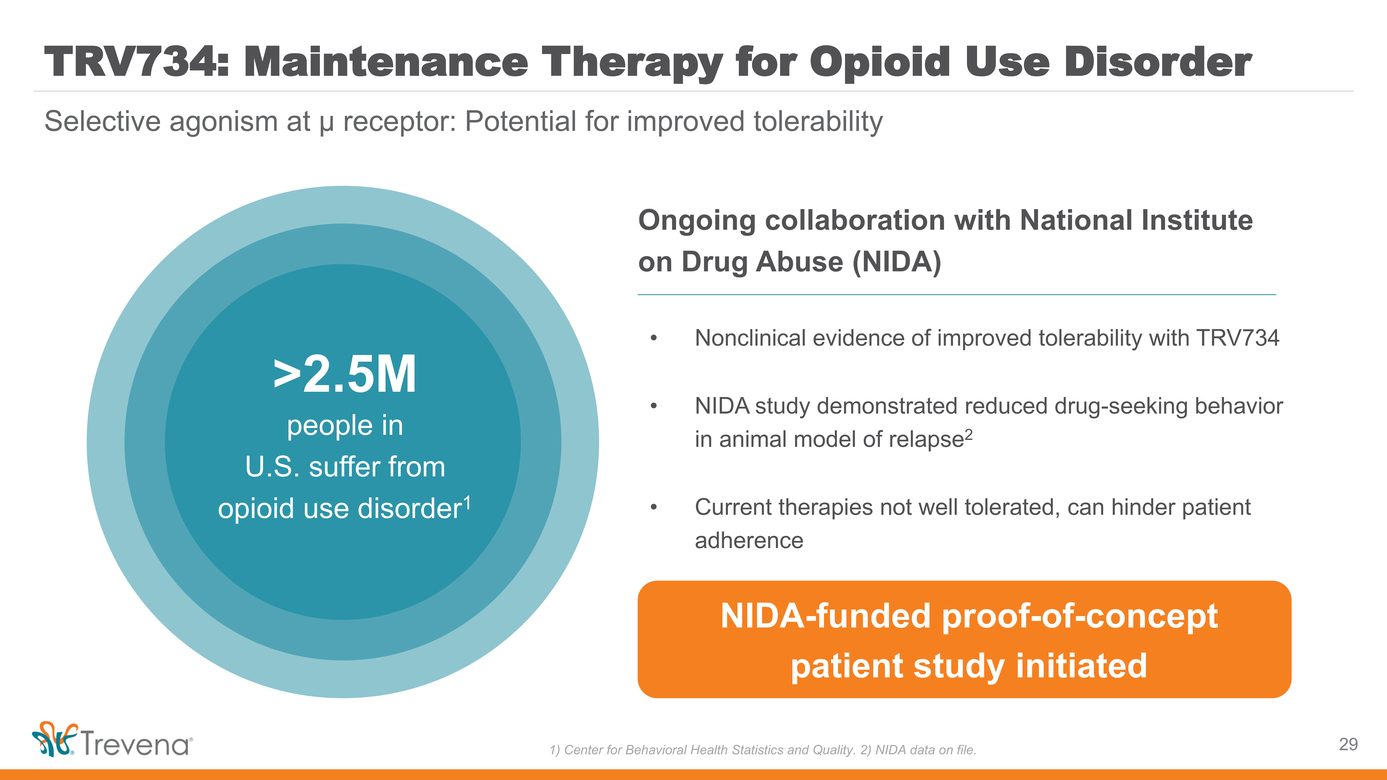 |
Selective agonism at µ receptor: Potential for improved tolerability >2.5M people in U.S. suffer from opioid use disorder1 Nonclinical evidence of improved tolerability with TRV734 NIDA study demonstrated reduced drug-seeking behavior in animal model of relapse2 Current therapies not well tolerated, can hinder patient adherence NIDA-funded proof-of-concept patient study initiated |
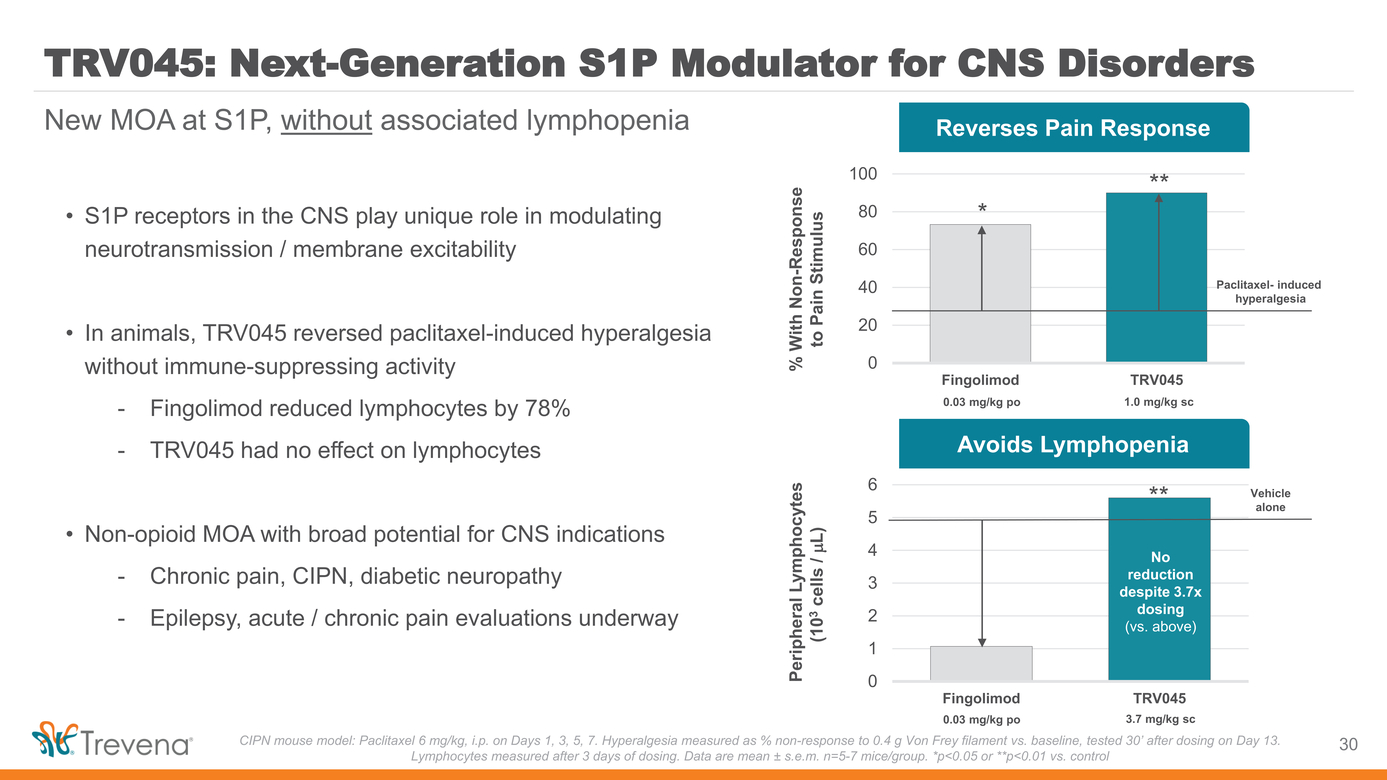 |
TRV045: Next-Generation S1P Modulator for CNS Disorders Reverses Pain Response S1P receptors in the CNS play unique role in modulating neurotransmission / membrane excitability In animals, TRV045 reversed paclitaxel-induced hyperalgesia without immune-suppressing activity 100 % With Non-Response to Pain Stimulus 60 40 20 0 ** Paclitaxel-induced hyperalgesia Fingolimod reduced lymphocytes by 78% TRV045 had no effect on lymphocytes Non-opioid MOA with broad potential for CNS indications Chronic pain, CIPN, diabetic neuropathy Epilepsy, acute / chronic pain evaluations underway FingolimodTRV045 0.03 mg/kg po1.0 mg/kg sc Avoids Lymphopenia 6 ** Vehicle alone No reduction despite 3.7x dosing (vs. above) Peripheral Lymphocytes (103 cells / L) 4 3 2 1 0 FingolimodTRV045 0.03 mg/kg po3.7 mg/kg sc |
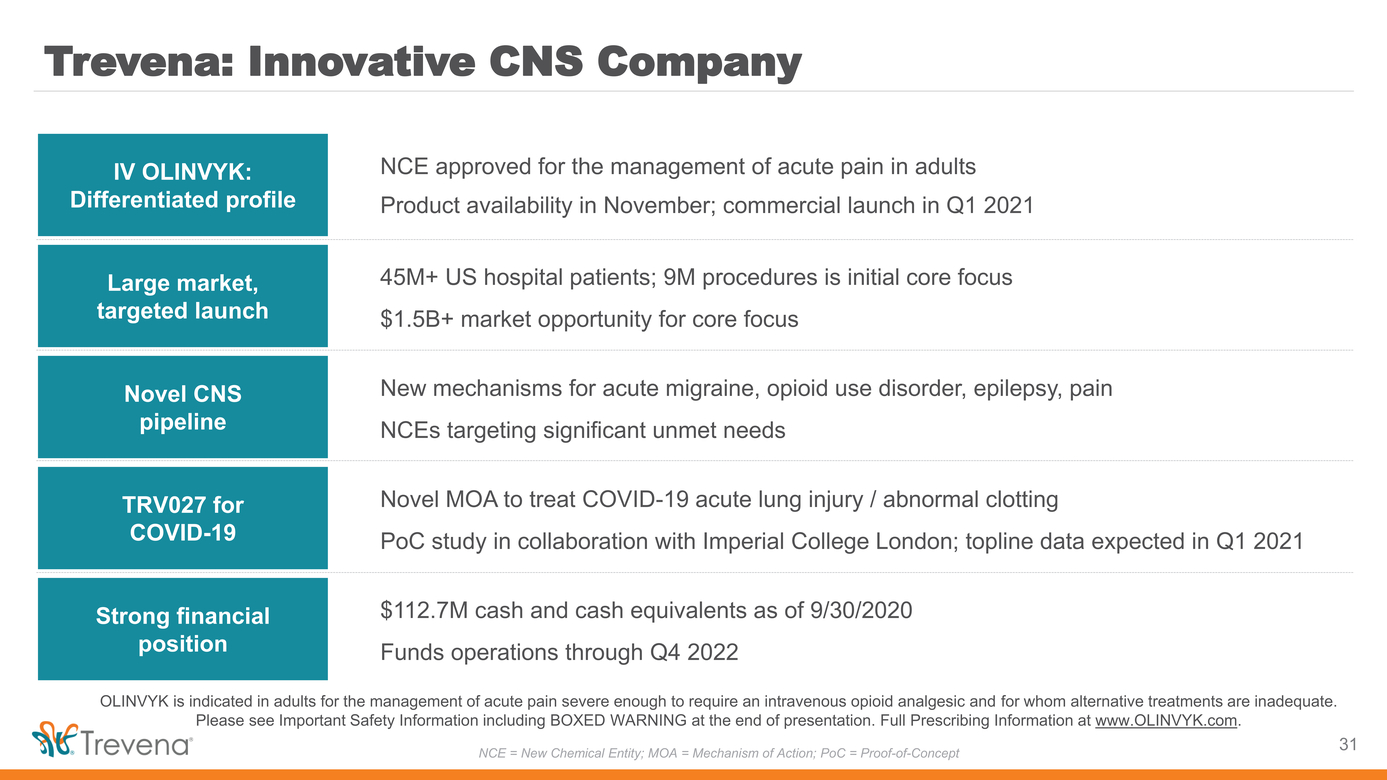 |
Trevena: Innovative CNS Company OLINVYK is indicated in adults for the management of acute pain severe enough to require an intravenous opioid analgesic and for whom alternative treatments are inadequate. Please see Important Safety Information including BOXED WARNING at the end of presentation. Full Prescribing Information at www.OLINVYK.com. |
 |
APPENDIX |
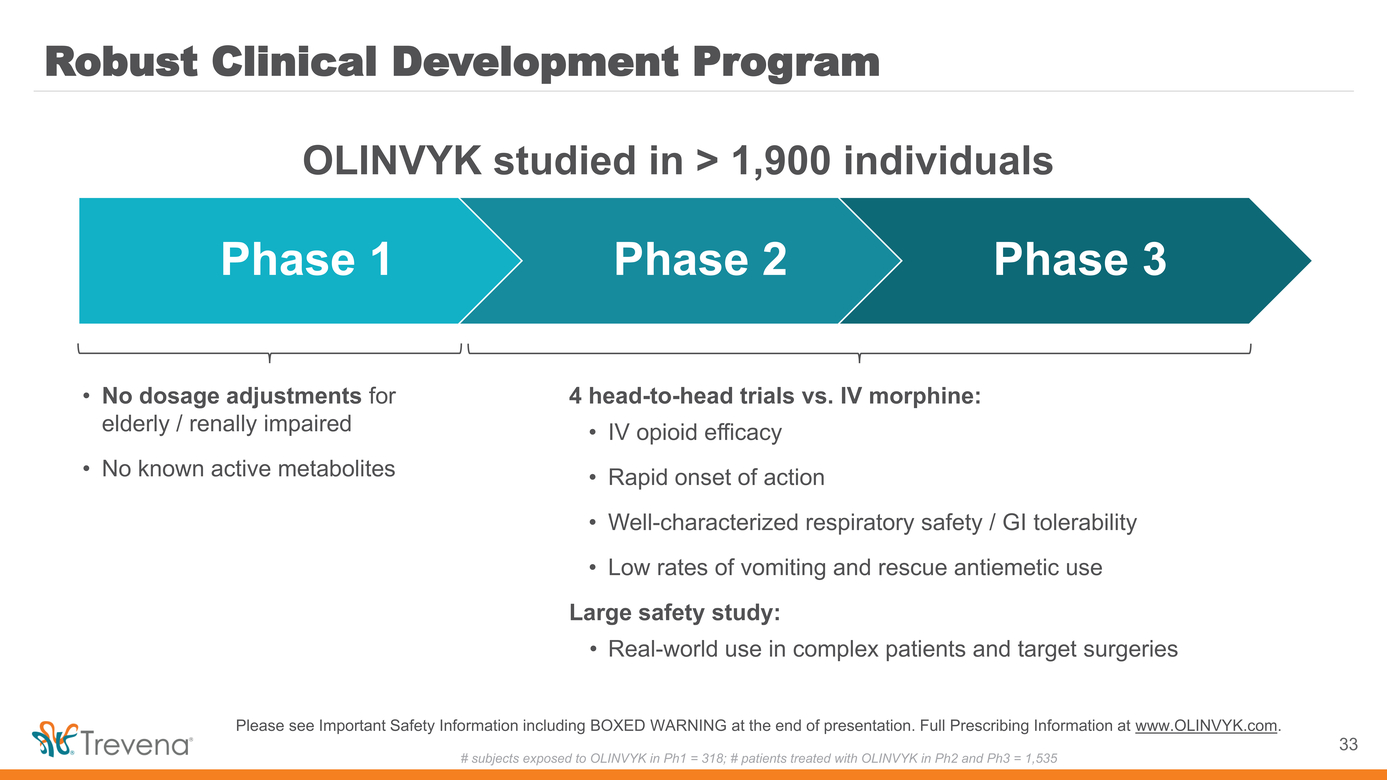 |
OLINVYK studied in > 1,900 individuals Phase 1 Phase 2 Phase 3 No dosage adjustments for elderly / renally impaired No known active metabolites 4 head-to-head trials vs. IV morphine: IV opioid efficacy Rapid onset of action Well-characterized respiratory safety / GI tolerability Low rates of vomiting and rescue antiemetic use Large safety study: Real-world use in complex patients and target surgeries Please see Important Safety Information including BOXED WARNING at the end of presentation. Full Prescribing Information at www.OLINVYK.com. |
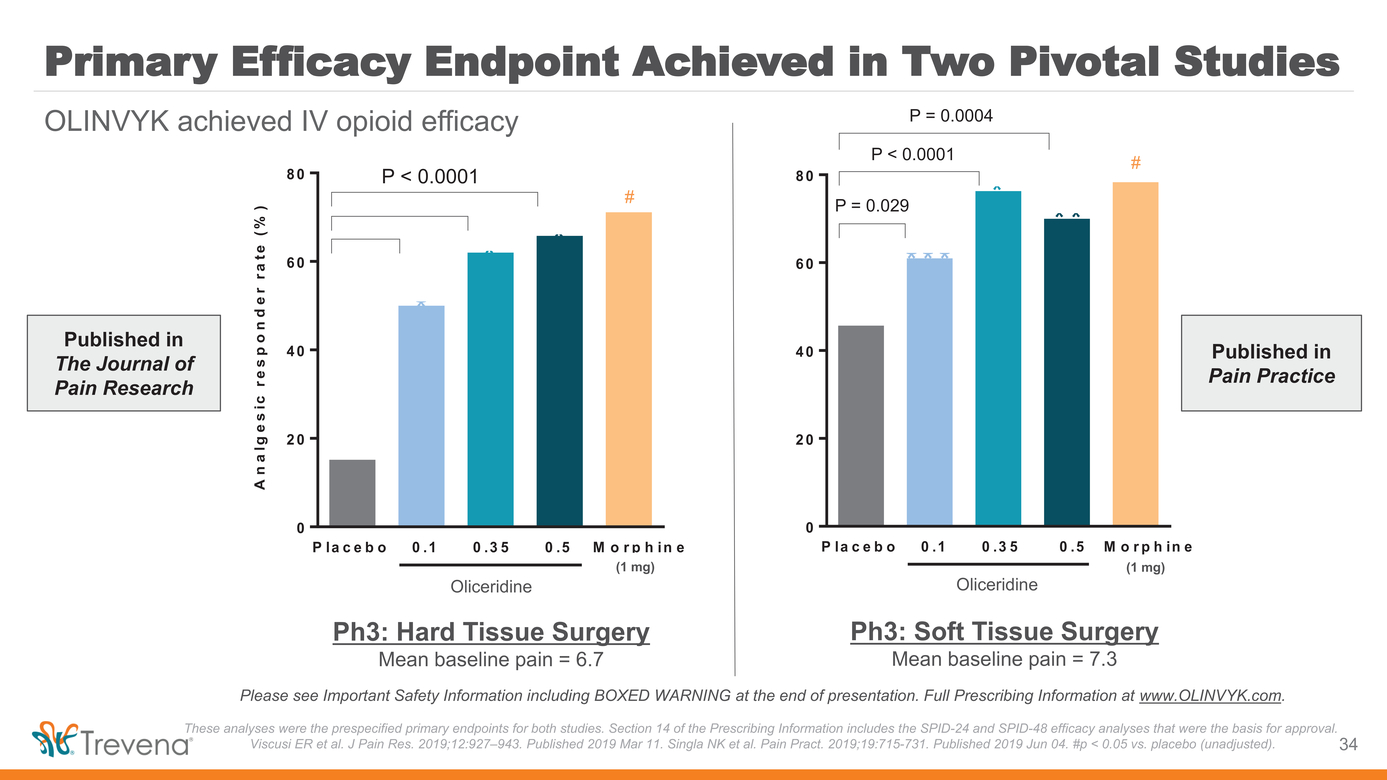 |
OLINVYK achieved IV opioid efficacy P < 0.0001 # * * * P = 0.0004 P = 0.029 * * * * * * 8 0 A n a lg e s ic r e s p o n d e r r a t e ( % ) Published in Pain Practice Published in The Journal of Pain Research 2 02 0 0 (1 mg) Oliceridine 0 P la c e b o0 . 10 . 3 50 . 5M o r p h in e O l in v o R e g im e n O l in v o R e g im e n Oliceridine Ph3: Hard Tissue Surgery Mean baseline pain = 6.7 Ph3: Soft Tissue Surgery Mean baseline pain = 7.3 Please see Important Safety Information including BOXED WARNING at the end of presentation. Full Prescribing Information at www.OLINVYK.com. These analyses were the prespecified primary endpoints for both studies. Section 14 of the Prescribing Information includes the SPID-24 and SPID-48 efficacy analyses that were the basis for approval. |
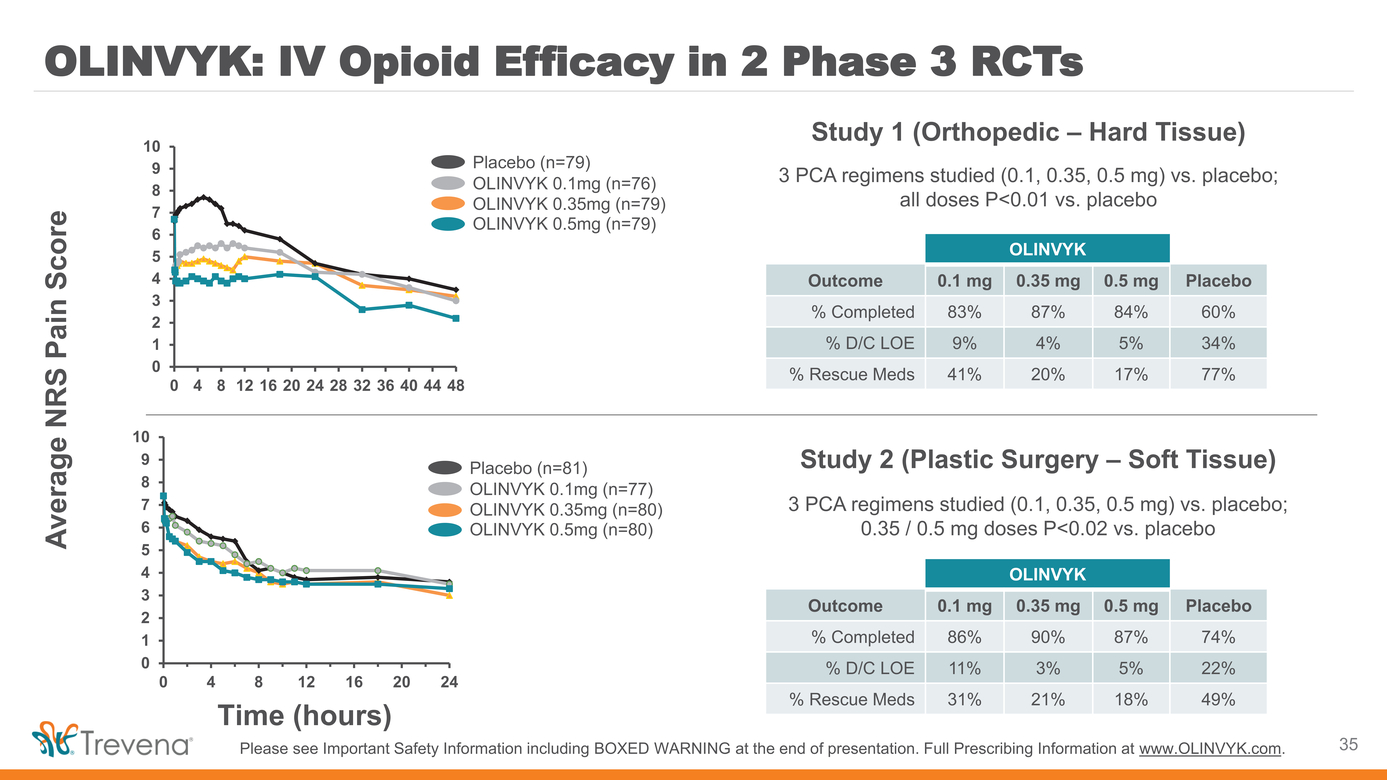 |
10 9 8 Average NRS Pain Score 6 5 4 3 2 1 0 048 12 16 20 24 28 32 36 40 44 48 Placebo (n=79) OLINVYK 0.1mg (n=76) OLINVYK 0.35mg (n=79) OLINVYK 0.5mg (n=79) Study 1 (Orthopedic – Hard Tissue) 3 PCA regimens studied (0.1, 0.35, 0.5 mg) vs. placebo; all doses P<0.01 vs. placebo 10 9 8 7 6 5 4 3 2 1 0 04812162024 Time (hours) Placebo (n=81) OLINVYK 0.1mg (n=77) OLINVYK 0.35mg (n=80) OLINVYK 0.5mg (n=80) Study 2 (Plastic Surgery – Soft Tissue) 3 PCA regimens studied (0.1, 0.35, 0.5 mg) vs. placebo; / 0.5 mg doses P<0.02 vs. placebo |
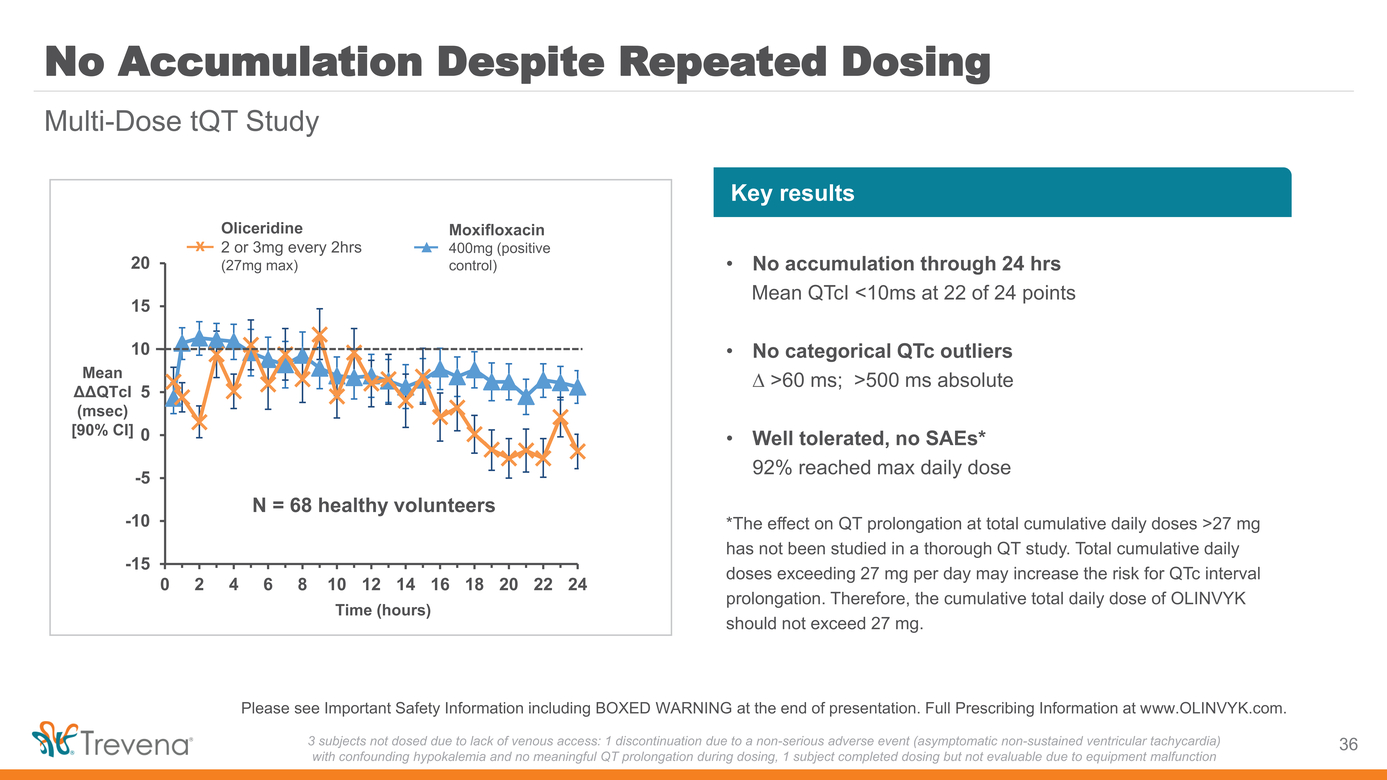 |
Multi-Dose tQT Study Key results 24 10121416182022 Time (hours) 02468 -15 N = 68 healthy volunteers 15 10 Mean ΔΔQTcI 5 (msec) [90% CI] 0 -5 -10 Moxifloxacin 400mg (positive control) Oliceridine x 2 or 3mg every 2hrs (27mg max) 20 Mean QTcI <10ms at 22 of 24 points No categorical QTc outliers ∆ >60 ms; >500 ms absolute Well tolerated, no SAEs* 92% reached max daily dose *The effect on QT prolongation at total cumulative daily doses >27 mg has not been studied in a thorough QT study. Total cumulative daily doses exceeding 27 mg per day may increase the risk for QTc interval prolongation. Therefore, the cumulative total daily dose of OLINVYK should not exceed 27 mg. Please see Important Safety Information including BOXED WARNING at the end of presentation. Full Prescribing Information at www.OLINVYK.com. |
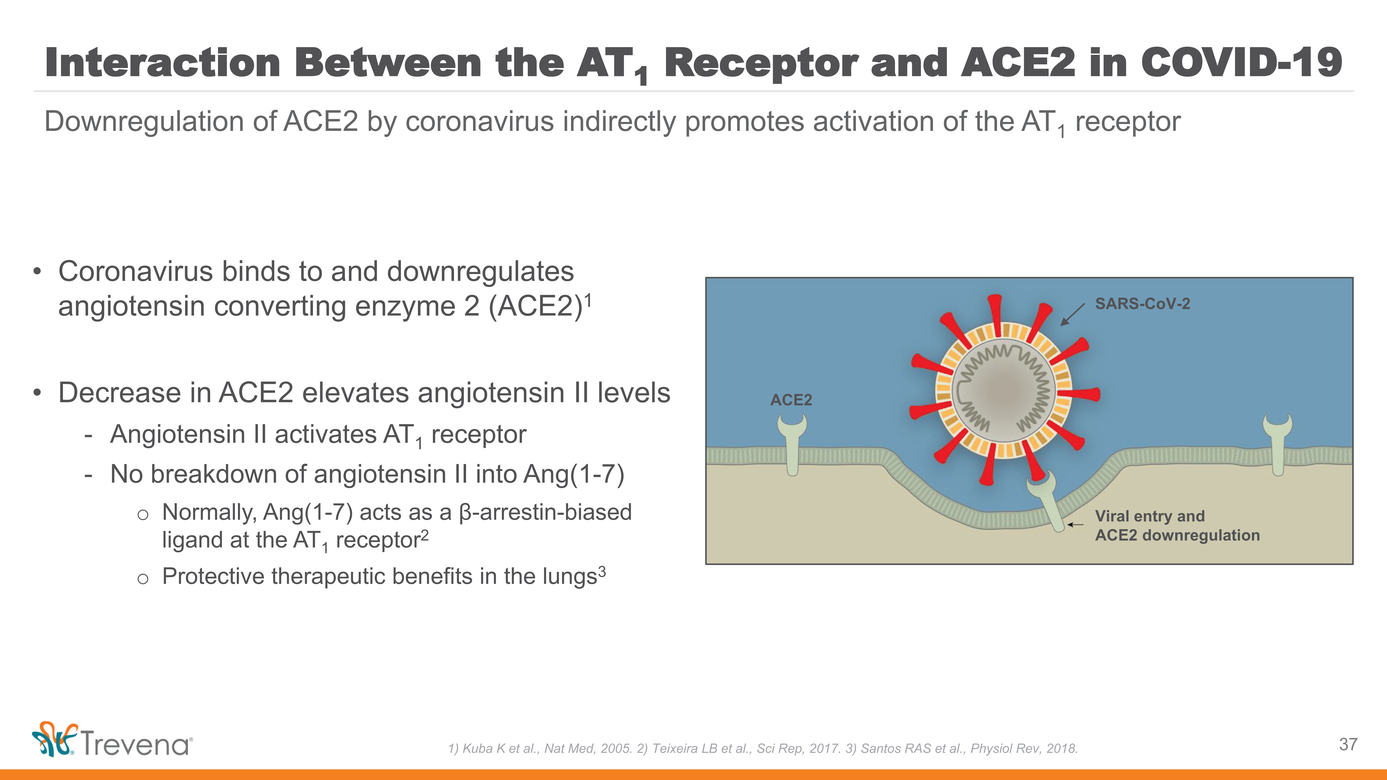 |
Interaction Between the AT1 Receptor and ACE2 in COVID-19 Downregulation of ACE2 by coronavirus indirectly promotes activation of the AT1 receptor SARS-CoV-2 ACE2 Viral entry and ACE2 downregulation Decrease in ACE2 elevates angiotensin II levels Angiotensin II activates AT1 receptor No breakdown of angiotensin II into Ang(1-7) Normally, Ang(1-7) acts as a β-arrestin-biased ligand at the AT1 receptor2 Protective therapeutic benefits in the lungs3 |
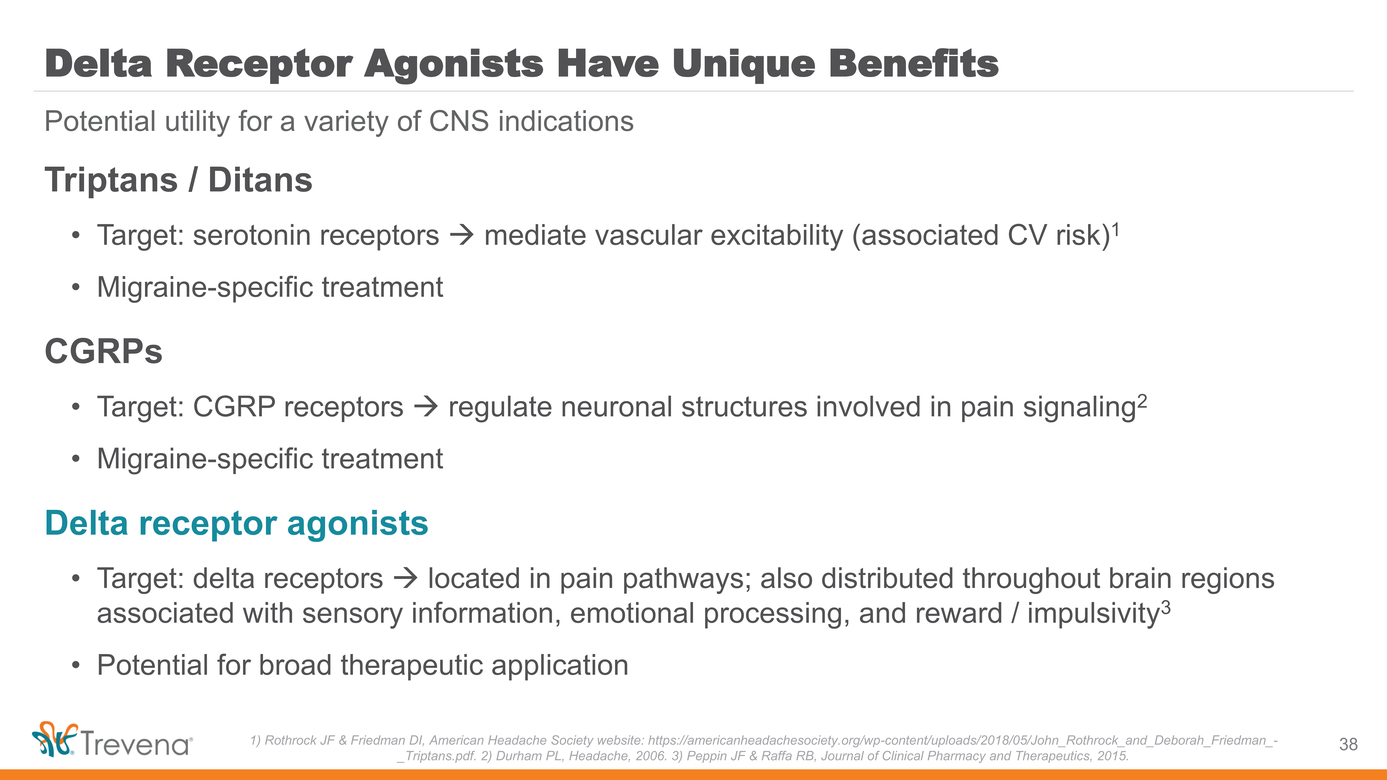 |
Delta Receptor Agonists Have Unique Benefits Potential utility for a variety of CNS indications Triptans / Ditans Target: serotonin receptors → mediate vascular excitability (associated CV risk)1 Migraine-specific treatment CGRPs Target: CGRP receptors → regulate neuronal structures involved in pain signaling2 Migraine-specific treatment Delta receptor agonists Target: delta receptors → located in pain pathways; also distributed throughout brain regions associated with sensory information, emotional processing, and reward / impulsivity3 Potential for broad therapeutic application 1) Rothrock JF & Friedman DI, American Headache Society website: https://americanheadachesociety.org/wp-content/uploads/2018/05/John_Rothrock_and_Deborah_Friedman_-38 |
 |
IMPORTANT SAFETY INFORMATION |
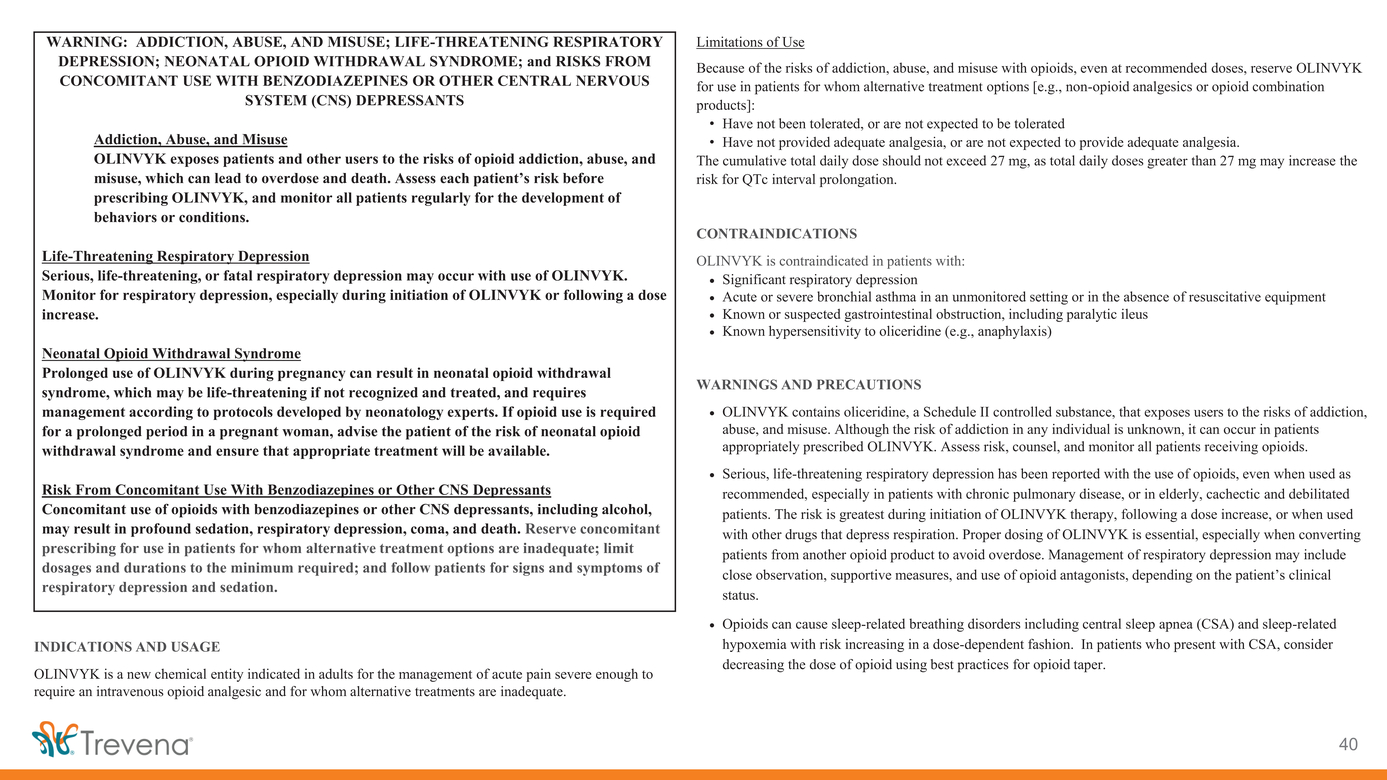 |
WARNING: ADDICTION, ABUSE, AND MISUSE; LIFE-THREATENING RESPIRATORY DEPRESSION; NEONATAL OPIOID WITHDRAWAL SYNDROME; and RISKS FROM CONCOMITANT USE WITH BENZODIAZEPINES OR OTHER CENTRAL NERVOUS SYSTEM (CNS) DEPRESSANTS Addiction, Abuse, and Misuse OLINVYK exposes patients and other users to the risks of opioid addiction, abuse, and misuse, which can lead to overdose and death. Assess each patient’s risk before prescribing OLINVYK, and monitor all patients regularly for the development of behaviors or conditions. Life-Threatening Respiratory Depression Serious, life-threatening, or fatal respiratory depression may occur with use of OLINVYK. Monitor for respiratory depression, especially during initiation of OLINVYK or following a dose increase. Neonatal Opioid Withdrawal Syndrome Prolonged use of OLINVYK during pregnancy can result in neonatal opioid withdrawal syndrome, which may be life-threatening if not recognized and treated, and requires management according to protocols developed by neonatology experts. If opioid use is required for a prolonged period in a pregnant woman, advise the patient of the risk of neonatal opioid withdrawal syndrome and ensure that appropriate treatment will be available. Risk From Concomitant Use With Benzodiazepines or Other CNS Depressants Concomitant use of opioids with benzodiazepines or other CNS depressants, including alcohol, may result in profound sedation, respiratory depression, coma, and death. Reserve concomitant prescribing for use in patients for whom alternative treatment options are inadequate; limit dosages and durations to the minimum required; and follow patients for signs and symptoms of respiratory depression and sedation. INDICATIONS AND USAGE OLINVYK is a new chemical entity indicated in adults for the management of acute pain severe enough to require an intravenous opioid analgesic and for whom alternative treatments are inadequate. Limitations of Use Because of the risks of addiction, abuse, and misuse with opioids, even at recommended doses, reserve OLINVYK for use in patients for whom alternative treatment options [e.g., non-opioid analgesics or opioid combination products]: Have not been tolerated, or are not expected to be tolerated Have not provided adequate analgesia, or are not expected to provide adequate analgesia. The cumulative total daily dose should not exceed 27 mg, as total daily doses greater than 27 mg may increase the risk for QTc interval prolongation. CONTRAINDICATIONS OLINVYK is contraindicated in patients with: Significant respiratory depression Acute or severe bronchial asthma in an unmonitored setting or in the absence of resuscitative equipment Known or suspected gastrointestinal obstruction, including paralytic ileus Known hypersensitivity to oliceridine (e.g., anaphylaxis) WARNINGS AND PRECAUTIONS OLINVYK contains oliceridine, a Schedule II controlled substance, that exposes users to the risks of addiction, abuse, and misuse. Although the risk of addiction in any individual is unknown, it can occur in patients appropriately prescribed OLINVYK. Assess risk, counsel, and monitor all patients receiving opioids. Serious, life-threatening respiratory depression has been reported with the use of opioids, even when used as recommended, especially in patients with chronic pulmonary disease, or in elderly, cachectic and debilitated patients. The risk is greatest during initiation of OLINVYK therapy, following a dose increase, or when used with other drugs that depress respiration. Proper dosing of OLINVYK is essential, especially when converting patients from another opioid product to avoid overdose. Management of respiratory depression may include close observation, supportive measures, and use of opioid antagonists, depending on the patient’s clinical status. Opioids can cause sleep-related breathing disorders including central sleep apnea (CSA) and sleep-related hypoxemia with risk increasing in a dose-dependent fashion. In patients who present with CSA, consider decreasing the dose of opioid using best practices for opioid taper. |
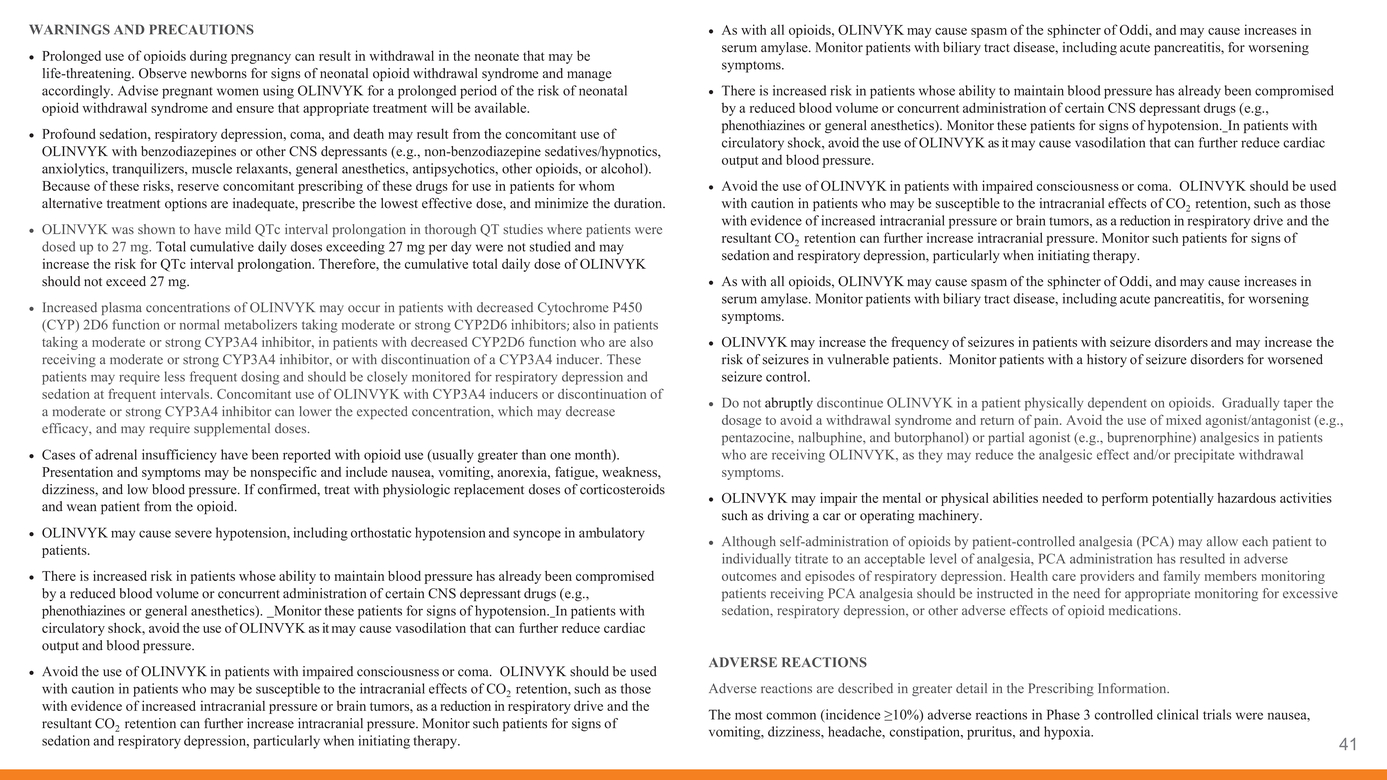 |
WARNINGS AND PRECAUTIONS Prolonged use of opioids during pregnancy can result in withdrawal in the neonate that may be life-threatening. Observe newborns for signs of neonatal opioid withdrawal syndrome and manage accordingly. Advise pregnant women using OLINVYK for a prolonged period of the risk of neonatal opioid withdrawal syndrome and ensure that appropriate treatment will be available. Profound sedation, respiratory depression, coma, and death may result from the concomitant use of OLINVYK with benzodiazepines or other CNS depressants (e.g., non-benzodiazepine sedatives/hypnotics, anxiolytics, tranquilizers, muscle relaxants, general anesthetics, antipsychotics, other opioids, or alcohol). Because of these risks, reserve concomitant prescribing of these drugs for use in patients for whom alternative treatment options are inadequate, prescribe the lowest effective dose, and minimize the duration. OLINVYK was shown to have mild QTc interval prolongation in thorough QT studies where patients were dosed up to 27 mg. Total cumulative daily doses exceeding 27 mg per day were not studied and may increase the risk for QTc interval prolongation. Therefore, the cumulative total daily dose of OLINVYK should not exceed 27 mg. Increased plasma concentrations of OLINVYK may occur in patients with decreased Cytochrome P450 (CYP) 2D6 function or normal metabolizers taking moderate or strong CYP2D6 inhibitors; also in patients taking a moderate or strong CYP3A4 inhibitor, in patients with decreased CYP2D6 function who are also receiving a moderate or strong CYP3A4 inhibitor, or with discontinuation of a CYP3A4 inducer. These patients may require less frequent dosing and should be closely monitored for respiratory depression and sedation at frequent intervals. Concomitant use of OLINVYK with CYP3A4 inducers or discontinuation of a moderate or strong CYP3A4 inhibitor can lower the expected concentration, which may decrease efficacy, and may require supplemental doses. Cases of adrenal insufficiency have been reported with opioid use (usually greater than one month). Presentation and symptoms may be nonspecific and include nausea, vomiting, anorexia, fatigue, weakness, dizziness, and low blood pressure. If confirmed, treat with physiologic replacement doses of corticosteroids and wean patient from the opioid. OLINVYK may cause severe hypotension, including orthostatic hypotension and syncope in ambulatory patients. There is increased risk in patients whose ability to maintain blood pressure has already been compromised by a reduced blood volume or concurrent administration of certain CNS depressant drugs (e.g., phenothiazines or general anesthetics). Monitor these patients for signs of hypotension. In patients with circulatory shock, avoid the use of OLINVYK as it may cause vasodilation that can further reduce cardiac output and blood pressure. Avoid the use of OLINVYK in patients with impaired consciousness or coma. OLINVYK should be used with caution in patients who may be susceptible to the intracranial effects of CO2 retention, such as those with evidence of increased intracranial pressure or brain tumors, as a reduction in respiratory drive and the resultant CO2 retention can further increase intracranial pressure. Monitor such patients for signs of As with all opioids, OLINVYK may cause spasm of the sphincter of Oddi, and may cause increases in serum amylase. Monitor patients with biliary tract disease, including acute pancreatitis, for worsening symptoms. There is increased risk in patients whose ability to maintain blood pressure has already been compromised by a reduced blood volume or concurrent administration of certain CNS depressant drugs (e.g., phenothiazines or general anesthetics). Monitor these patients for signs of hypotension. In patients with circulatory shock, avoid the use of OLINVYK as it may cause vasodilation that can further reduce cardiac output and blood pressure. Avoid the use of OLINVYK in patients with impaired consciousness or coma. OLINVYK should be used with caution in patients who may be susceptible to the intracranial effects of CO2 retention, such as those with evidence of increased intracranial pressure or brain tumors, as a reduction in respiratory drive and the resultant CO2 retention can further increase intracranial pressure. Monitor such patients for signs of sedation and respiratory depression, particularly when initiating therapy. As with all opioids, OLINVYK may cause spasm of the sphincter of Oddi, and may cause increases in serum amylase. Monitor patients with biliary tract disease, including acute pancreatitis, for worsening symptoms. OLINVYK may increase the frequency of seizures in patients with seizure disorders and may increase the risk of seizures in vulnerable patients. Monitor patients with a history of seizure disorders for worsened seizure control. Do not abruptly discontinue OLINVYK in a patient physically dependent on opioids. Gradually taper the dosage to avoid a withdrawal syndrome and return of pain. Avoid the use of mixed agonist/antagonist (e.g., pentazocine, nalbuphine, and butorphanol) or partial agonist (e.g., buprenorphine) analgesics in patients who are receiving OLINVYK, as they may reduce the analgesic effect and/or precipitate withdrawal symptoms. OLINVYK may impair the mental or physical abilities needed to perform potentially hazardous activities such as driving a car or operating machinery. Although self-administration of opioids by patient-controlled analgesia (PCA) may allow each patient to individually titrate to an acceptable level of analgesia, PCA administration has resulted in adverse outcomes and episodes of respiratory depression. Health care providers and family members monitoring patients receiving PCA analgesia should be instructed in the need for appropriate monitoring for excessive sedation, respiratory depression, or other adverse effects of opioid medications. ADVERSE REACTIONS Adverse reactions are described in greater detail in the Prescribing Information. The most common (incidence ≥10%) adverse reactions in Phase 3 controlled clinical trials were nausea, vomiting, dizziness, headache, constipation, pruritus, and hypoxia. |